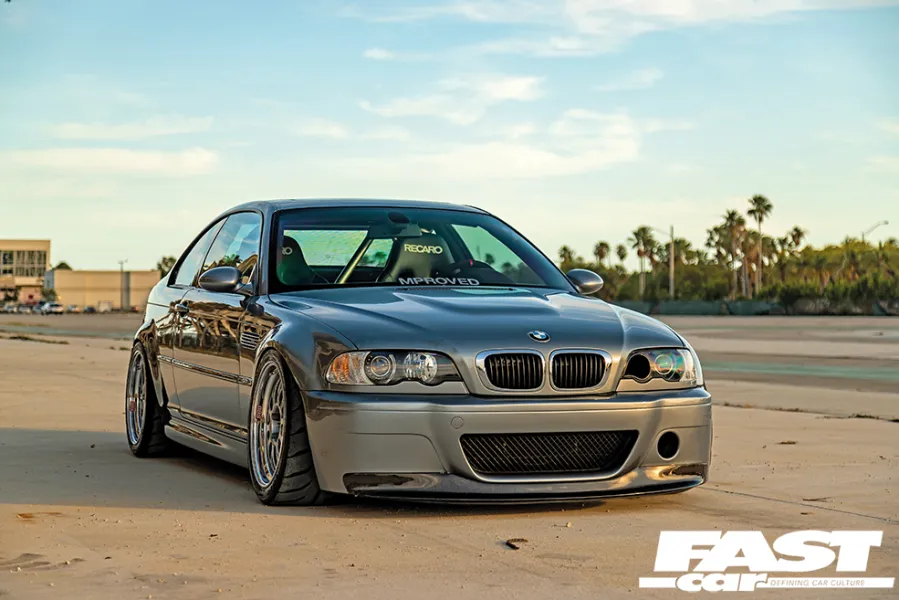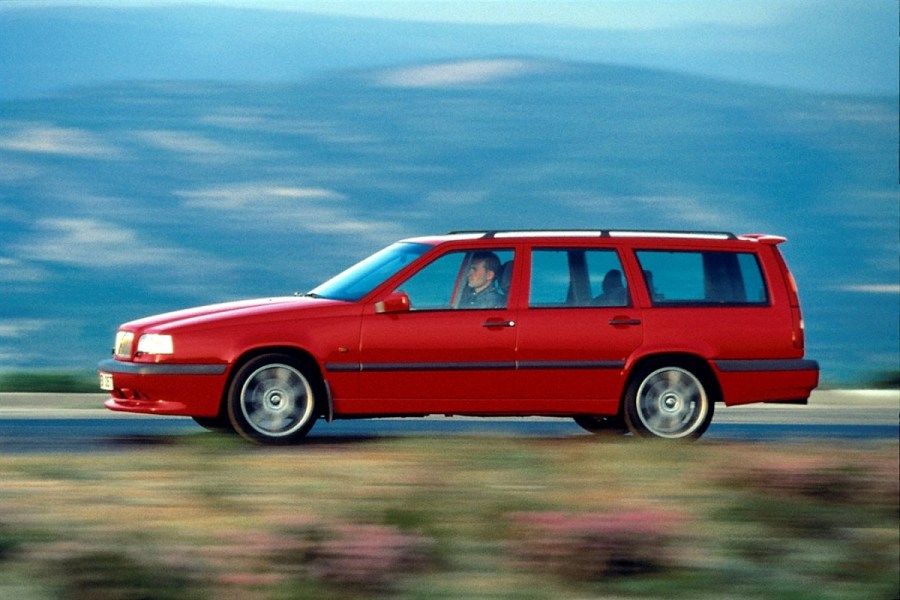Looking for something fun to drive but can’t afford something new? Here’s our guide to the best used cars to buy that will guarantee to make you smile.
The used car market is so ridiculously massive, you’ve got to go into it with one or two filters in place or you risk being overwhelmed. What type of thing are you hoping to bring into your life? We’d imagine it’s something fast, agile, powerful, entertaining… but perhaps there are compromises too. Maybe you need extra space to carry the kids/pets/sporting equipment. Maybe you need something with sober aesthetics so you can at least pretend to your work colleagues that you’re being sensible. And, if you’re buying a used car, it probably means you want those attributes at a cheaper rate than what a dealer will charge you for something new.
Whatever the criteria, I think there will be something here that you like. This list pulls together some of the best used cars to line up in your crosshairs right now; we’ve got some modern choices, some from back in the nineties, and a bunch of cars in-between. Each one represents a decent balance of desirability and value and – this being Fast Car – they’re all excellent to drive. So which one are you going to pick?
Best Used Cars To Buy
In this article:
- Best Used Sedans
- Best Used Sports Coupes
- Best Used Hot Hatches
- Best Used Muscle Cars
- Best Used Convertibles
- Best Used Station Wagons
- Best Used SUVs
- Best Used Pickups
- Best Used Luxury Sedans
- Best Used Electric Cars
- Best Used Grand Tourers
- Best Used Supercars
Best Used Sedans
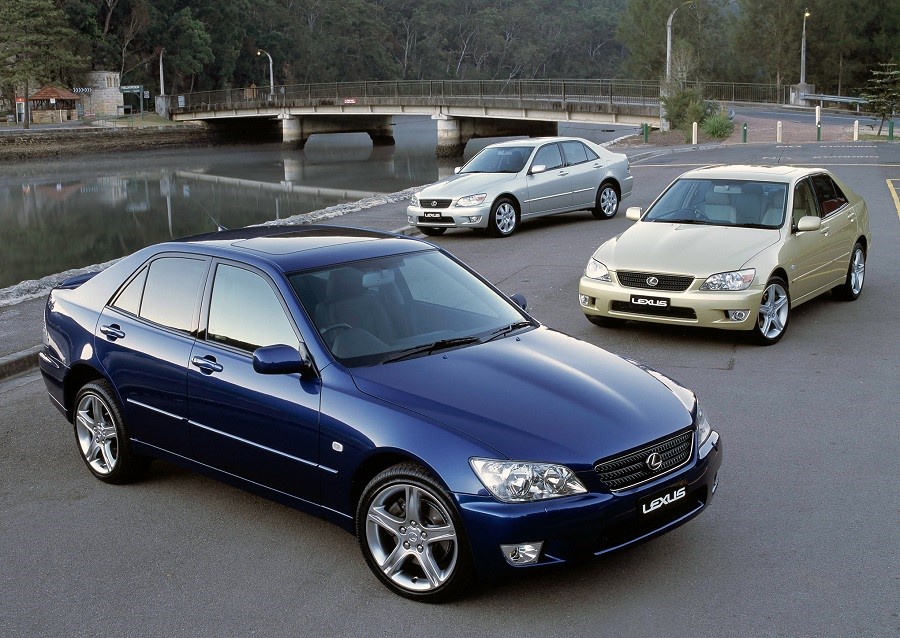
Lexus IS 300
Pros: affordable, good engine options.
Cons: Lots of rusty examples on the market.
If you haven’t got all that much budget to work with, the first-generation Lexus IS 300 is a very good shout. Sure, the interior might be a little dated in 2023, but what would you expect from a car designed in the ‘90s? I still think the outside looks great though – let’s not forget, this is the car that sparked the whole ‘Lexus lights’ aftermarket modifying trend, thanks to its clear factory taillights. So, it’s always had style, and to our eyes the front end in particular still looks sharp.
Looks are subjective though. What can’t be disputed is the fact that mechanically, this car is rewarding out of the box, and has the potential to become a real enthusiast’s dream with a little tweaking. What you get is a rear-wheel drive platform hooked up to a 3.0-liter 2JZ straight-six engine – yes, the same core architecture found in the Mk4 Supra (albeit N/A, rather than turbocharged). Despite its much-heralded DNA, the IS 300 isn’t particularly fast by modern standards, but will steel feel brisk enough around town. If you do fancy more than 217hp though, the aftermarket for 2JZs is huge. Plus, you can pick up a Mk1 IS with either a manual or automatic transmission, and if you’re attentive, you might be able to bag one with a standard limited-slip diff too.
So, whether you simply want a quick, practical cruiser, or are looking for your next drift project, the IS 300 can do it all.
How much?
- $6,000-$15,000
- £3,000-£8,000
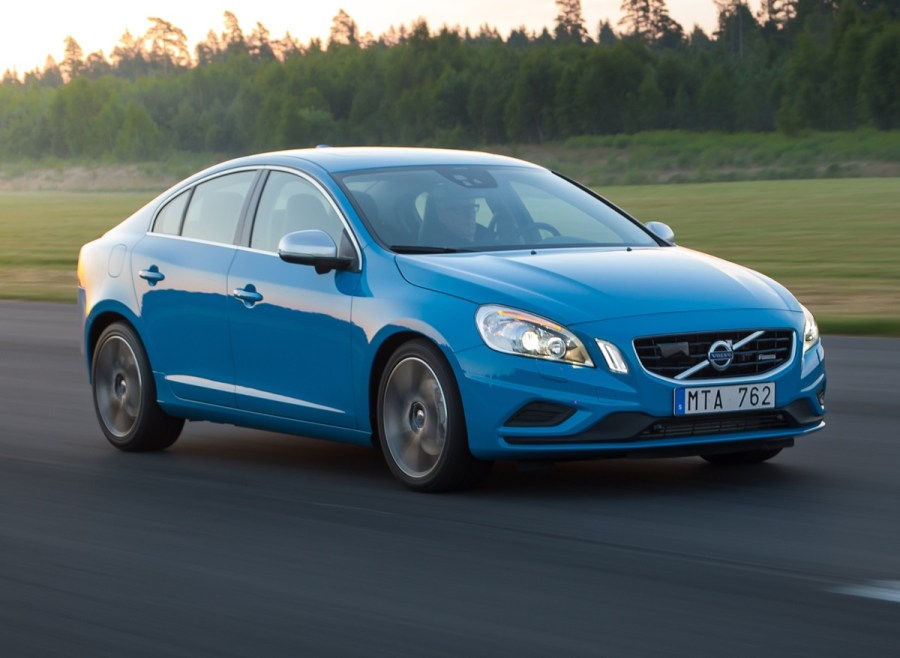
Volvo S60
Pros: Deceptively powerful, safe, great value.
Cons: anonymous styling, lack of prestige.
In the used market, value for money is everything, and for its age, the second-generation Volvo S60 excels in this department. In particular, we’re keen on the T6 R-Design variant – after all, there aren’t that many sedans at its price point which produce a mighty 325bhp, but can also comfortably handle a family trip to Ikea.
Unlike the first-gen cars, in T6 R-Design-spec, the second-gen S60 could be had with Haldex all-wheel drive, which matched its six-pot powertrain perfectly. Truth be told, these S60s are the subtle choice. They’ll slip through traffic unnoticed by passers-by, allowing you to enjoy the car’s performance without making any bold visual statement. Plus, as I’m sure you know, if you want a car that’s safe above all else, buy a Volvo. The Swedes take such matters terrifically seriously, and as such, Volvo has led the way in occupant and pedestrian safety for quite some time. If you’re looking for a family car, that might be the biggest draw of all.
How much?
- $12,000-$30,000
- £12,000-£18,000
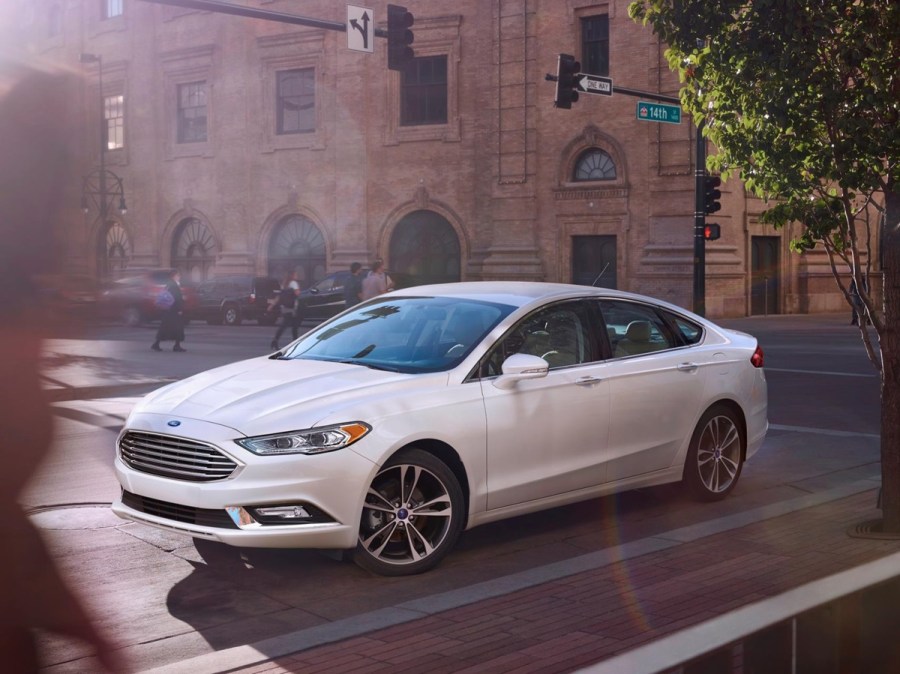
Ford Fusion / Ford Mondeo
Pros: attractive styling, great value, reliable.
Cons: some other sedans are roomier, not quite sporty.
The Ford Fusion and its European Ford Mondeo counterpart may have recently succumbed to the SUV fad, but the outgoing generation is nevertheless a brilliant sedan. I don’t think its too controversial to suggest that it’s the best looking family sedan on the market, what with its Aston Martin-esque nose, and there’s substance behind the style too.
Its engine range is certainly on the economical side, but thanks to Ecoboost technology, the lack of displacement doesn’t leave this car feeling short of breath on a regular drive. Steering is a bit light, but you only really notice that when you’re pushing it – which you probably won’t be doing 99% of the time. As far as tech goes, if you buy a later model you’ll get access to all the core creature comforts that we’ve become used to, whether it be parking sensors or Apple CarPlay/Android Auto. Trim levels make a particularly notable difference to the styling and equipment offered with these cars, so aim for a Titanium or Platinum if one’s within budget.
This isn’t a premium vehicle, but if you’re looking for a practical, affordable to run daily-driver, you could certainly do a lot worse than one of these. Though, if interior space is your highest priority, it may be worth checking out the Chevrolet Impala or Chyrsler 300C of the same model year.
How much?
- $5,000-$30,000
- £4,000-£27,000
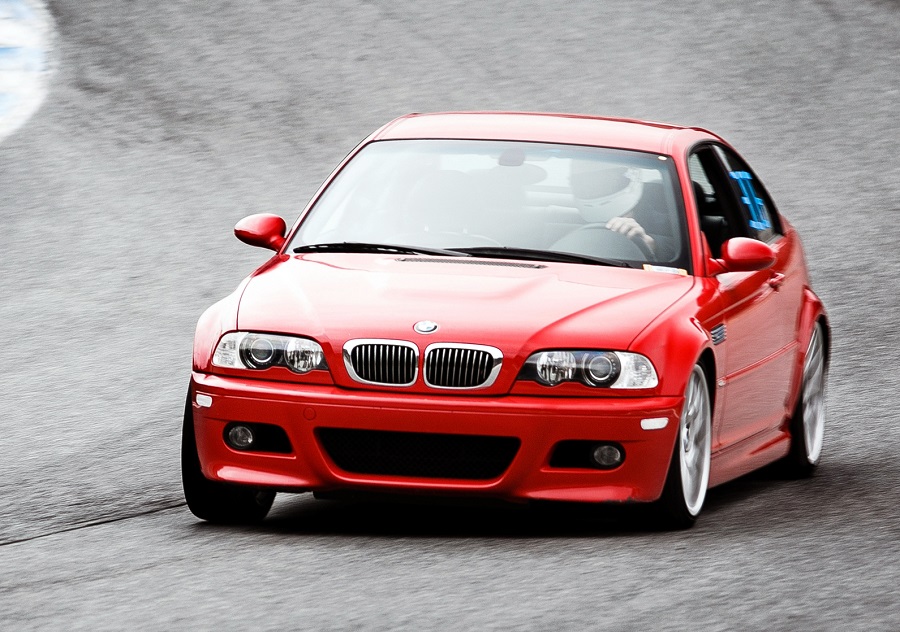
BMW M3
Pros: brilliant engine and handling, arguably the best M car ever.
Cons: getting more collectible, and therefore more expensive.
The BMW M3 E46. It’s modern enough to be solid and dependable, yet old enough to provide an analogue driving experience. It’s a hell of a looker too. And this, for a lot of people, is the classic M formula – muscular straight-six up front, drive to the rear wheels, planted handling and plenty of power. When the E46 M3 launched in late-2000, its engine featured the highest specific output of any mainstream BMW motor to date, with 343bhp from its 3.2-litre six.
Now, the wealthy collectors are chasing after the Coupé Sport Leichtbau, or CSL, of 2004 – but as the prices of those limited-editions start to get silly, the ‘mainstream’ E46 M3s are starting to look like very decent value. Available as either two-door coupé or cabriolet, buyers had the option of a six-speed manual or SMG-II transmission to go with their hugely powerful S54. Standard kit included 18” M wheels, leather upholstery, xenon headlights (bi-xenons on post-2001 cars), sports seats, sports suspension, Dynamic Throttle Control, cruise control, titanium interior trim, Cornering Brake Control, ISOFIX points and a trip computer. It’s well-specced, practical and pleasingly comfortable, yet also able to lap the Nordschleife in 8:22, all available today for the price of a basic new hatchback. Now’s the time to grab one before the collectors realize!
How much?
- $12,000-$30,000
- £13,000-£40,000
Looking to buy one? Check out our BMW E46 M3 buyer’s guide packed full of advice.
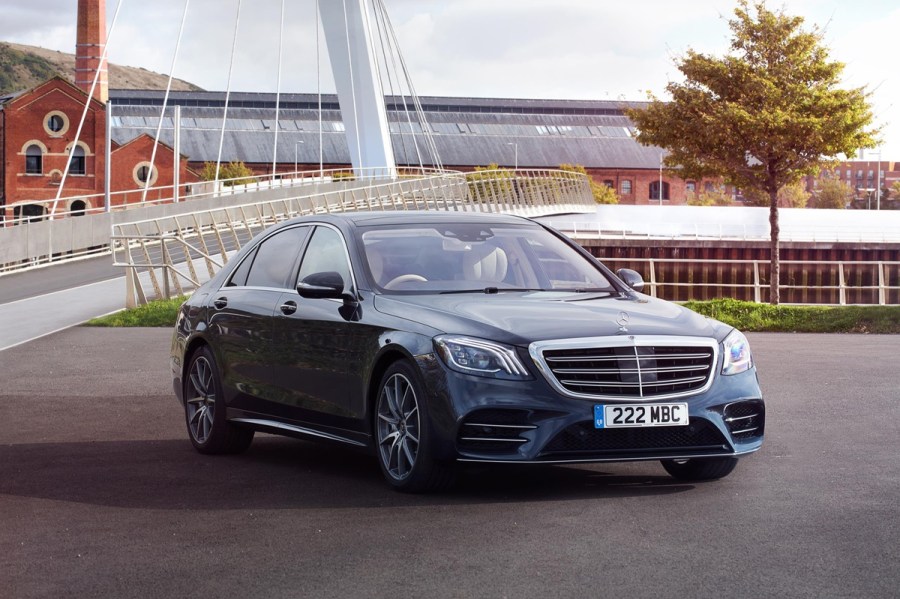
Mercedes-Benz S Class
Pros: comfortable, refined interior, handles well for a big car.
Cons: can be expensive to maintain.
Ok, so what if you’ve got plenty of cash to spend, but comfort and luxury is more important to you than handling and performance? Well, the Mercedes-Benz S Class is probably your best option, this side of a Rolls-Royce. In particular, we’re interested in the outgoing sixth-generation W222 model.
The W222 represents an awful lot of car for the money. Petrol engine options *start* with a 450hp V8, and extend all the way up to a 530hp V12. Granted, the intention is that these big engines will be able to soak up motorway miles with ease, but they’re also really rather brisk if you want them to be. For the eco-conscious, hybrid options are available too, and if you’ve still got a hankering for diesel, there’s one of those engines available as well. Though it’d rather take away some of the majesty of the car.
Normally, we would have second thoughts about investing in an old luxury car as high-end as this, as when they go wrong, the bill can be eye-watering. Fortunately, the W222 is still pretty fresh, and if you get a good one, you’ll almost certainly be able to enjoy its strengths for many years before any hint of a weakness begins to show. If you want to feel like you’ve made it in life, the S Class is the car to do it.
How much?
- $20,000-$150,000
- £14,000-£80,000
Best Used Sports Coupe
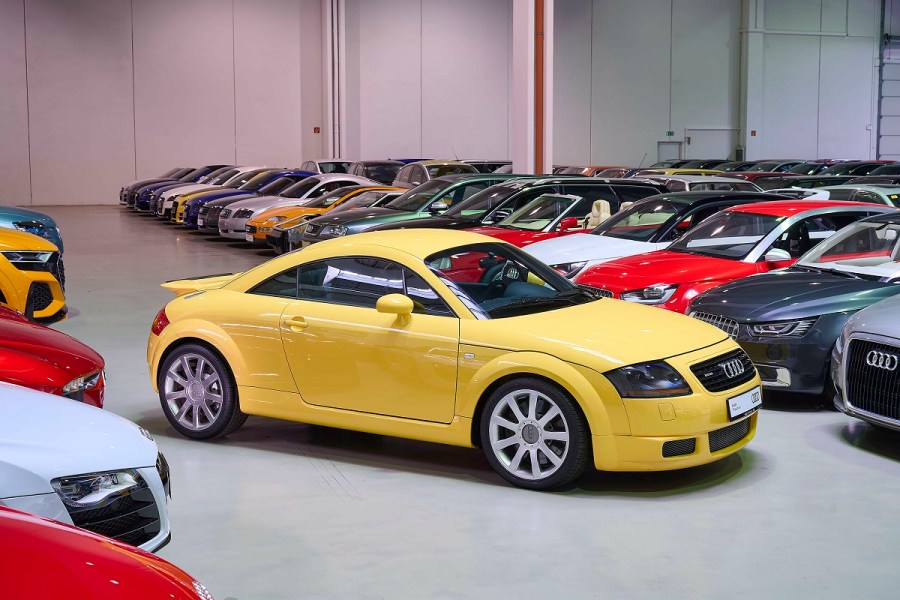
Audi TT
Pros: plenty on the market at affordable prices.
Cons: handling isn’t as good as some rivals.
The success of the early TT speaks for itself – the showroom model was amazingly close to the design of the original concept car, and these little spaceships sold like hot cakes. The Mk1 TT shifted in massive numbers, which means that there’s plenty out there to choose from – and with an increasing rate of attrition, this is a modern classic that you can hold onto and watch the values rise, while still enjoying it every day. Hard not to conclude it’s one of the best used cars to buy.
There were quite a lot of spec variants; you could get a FWD setup with the lower-powered engines or the full-fat quattro system with the sportier ones. Engine-wise, you had a choice of either a 1.8T or a 3.2 VR6, although it wasn’t quite that simple – the 1.8T could be had with 150bhp, 180bhp, or the brawny 225bhp in the aptly-named TT 225.
The 3.2 came with a DSG box and improved aero, although many argue that its 247bhp figure isn’t enough of a gain over the lighter and more easily tunable 225-spec 1.8T. And it’s the 225 we’re championing here: as well as the quattro AWD system. You also got the BAM engine, which is essentially a 1.8T on steroids; it had uprated pistons and rods, increased fueling and larger intercoolers. You get all kinds of toys with the 225 too – look at the cars for sale to find one with the Bose audio option and the heated leather seats. If you’re really lucky, you might even find one with the brilliantly weird baseball leather option.
How much?
- $4,000-$11,000
- £3,000-£10,000
Check out our Audi TT Mk1 buyer’s guide for advice when buying one.
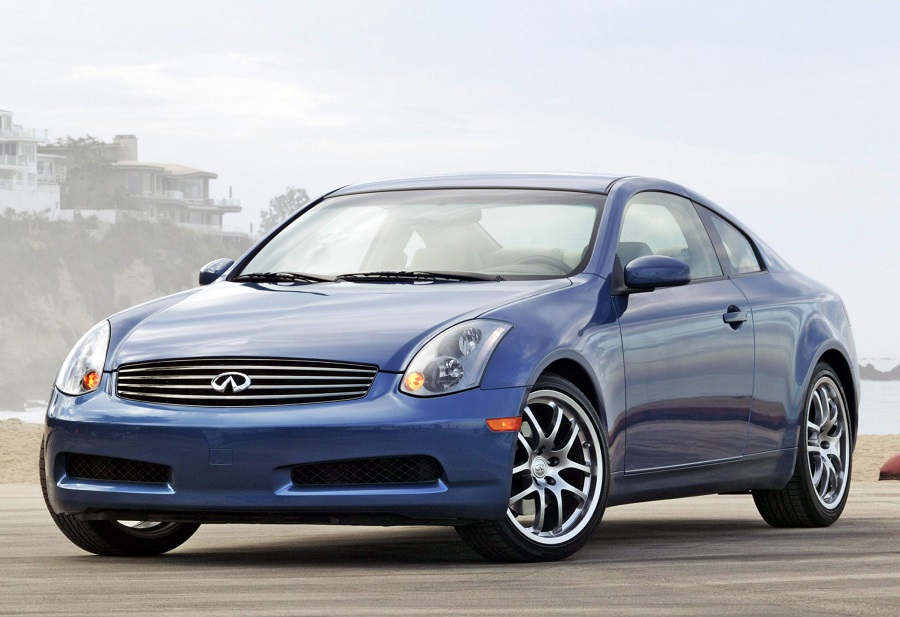
Infiniti G35
Pros: great value for money, available as coupe or sedan.
Cons: many have been poorly looked after.
It’s easy to pick fun at the G35. Some people see it as nothing more than a re-shelled, watered-down 350Z, while others are put off by the rowdy associations linked to its drivers. But we’re here to tell you to stop caring what other people think. The truth is, value is hard to find in the modern used car market, but if it’s value that you’re after, the G35 is a brilliant option.
Based on the JDM-only V35-spec Nissan Skyline, you can pick up a G35 in the US as either a 3-door coupe (pictured above) or 4-door sedan. So, whether you’re a college student or a family man, the G35 can do it all. It shares its engine range and chassis with the Nissan 350Z, meaning it has a 52/48 weight distribution and the VQ35 V6 motor under the hood. Cynics will make trumpet jokes about its exhaust note, but hey, call me crazy but I like the sound of the VQ. There, I said it!
Depending on the trim level you go for, you’ll either have 260hp or 282hp at your disposal, or 298hp in the later 05-07 cars. In a rear-wheel drive platform, that can certainly be fun. Oh, and that reminds me – there’s a sub-variant of this car called the G35x, which comes packed with Nissan’s ATTESA-ETS AWD system. Yeah, that’s right, the same kit that Nissan used in its ’90s GT-R icons (albeit not the full Pro version).
Overall, for $10k or less, you’d be hard-pushed to find a better Japanese tuner car – if you can get past its online reputation.
How much?
- $5,000-$25,000
- £3,000-£10,000
Fancy a Japanese car that’s a little more exotic? Check out the best JDM classics eligible for US import.
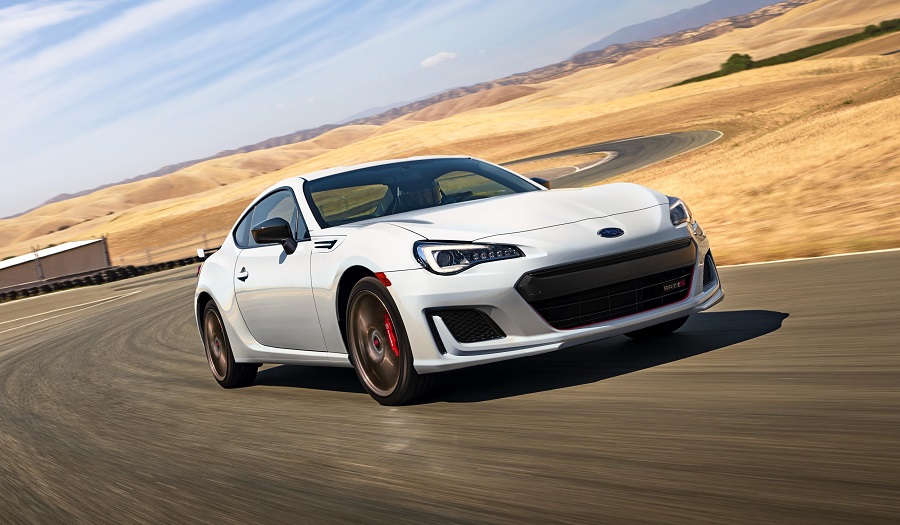
Subaru BRZ
Pros: excellent handling, huge aftermarket presence.
Cons: underpowered engine.
Ah, the triplet darlings of the modern motoring age. The Toyota GT 86 / Subaru BRZ / Scion FR-S is undoubtedly one of the best enthusiast cars to emerge from the 2010s. Sure, it may only produce 197-204hp from its FA20 Boxer engine, but that’s not the point. These little coupes are meant for fun, and I hate to break it to ya, but you don’t always need tons of power to enjoy your time behind the wheel.
From the factory, these cars had skinny Prius tires, a six-speed manual gearbox (though you could also have an auto), limited-slip differential, and a kerb weight of just 1190kg-1298kg (2624–2862 lbs). If you know about handling dynamics, it doesn’t take long to figure out where Toyota & Subaru were going with this. It’s perfect not only for spirited runs on back roads, but also for days out on the drift circuit. And let’s be real, many of the people who bought these did so with the intention of modifying them.
Speaking of which, the aftermarket for these is more plentiful than just about any other modern car, so you can easily improve upon any of the perceived deficiencies this platform might have.
So, what distinguishes the three cars from each other? Well, the obvious factor is the styling. Admittedly, you’ve really got to pay attention to spot the differences, but each brand offers a different front fascia and different color palettes. Likewise, there are small alterations between interior materials and furnishings, but for the most part, above all else what you’re really choosing is which badge you want on the front.
How much?
- $10,000-$35,000
- £9,000-£25,000
Check out our Subaru BRZ buyer’s guide for more advice.
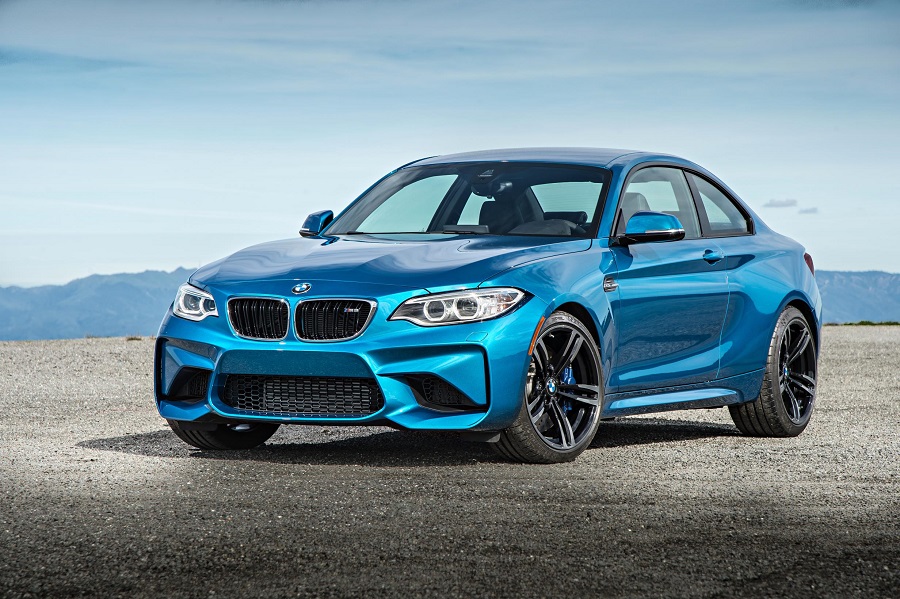
BMW M2
Pros: engine and handling are superb.
Cons: quite expensive.
It might be the smallest, but those in the know will tell you that the M2 is also the best 2010s-era M Car to drive. Its diminutive platform and lighter kerb weight make it inherently better set-up to deal with high-performance scenarios. Of course, being the baby of the M-range, BMW doesn’t allow it to have as much power from the factory as its bigger M3 and M4 siblings, but that really is the only area in which it falls down. In fact, some would even go as far as to say that this is the true spiritual successor to beloved M3s of old.
It debuted back in 2015, featuring a turbocharged 3.0-liter N55 straight-six, capable of 365hp and 343lb ft of torque. The power unit was hooked up to either a six-speed manual transmission or a seven-speed auto, which sent power directly to the rear wheels. Then in 2018, BMW added the Competition trim level into the mix (which would eventually entirely replace the base car).
S55 engine update
This updated variant featured, amongst other touches, the headline attraction of BMW’s S55 engine – in simplistic terms, a high-performance version of the old car’s N55. In addition to an extra turbo, the S55 benefits from a whole plethora of internal revisions and upgrades, designed to make it stronger than the N55. It’s also worth noting that while the S55 is indeed the same engine used in the F80 M3 & M4, the version which made its way into the M2 was detuned to 410hp.
Still, everyone knows all about the potential that lies within the S55 block, so if you can fork out the extra cash for an M2 Comp, it’d make one epic long-term performance project. And besides, 99% of the time, the base car will be more than capable of putting a smile on your face.
How much?
- $35,000-$65,000
- £25,000-£50,000
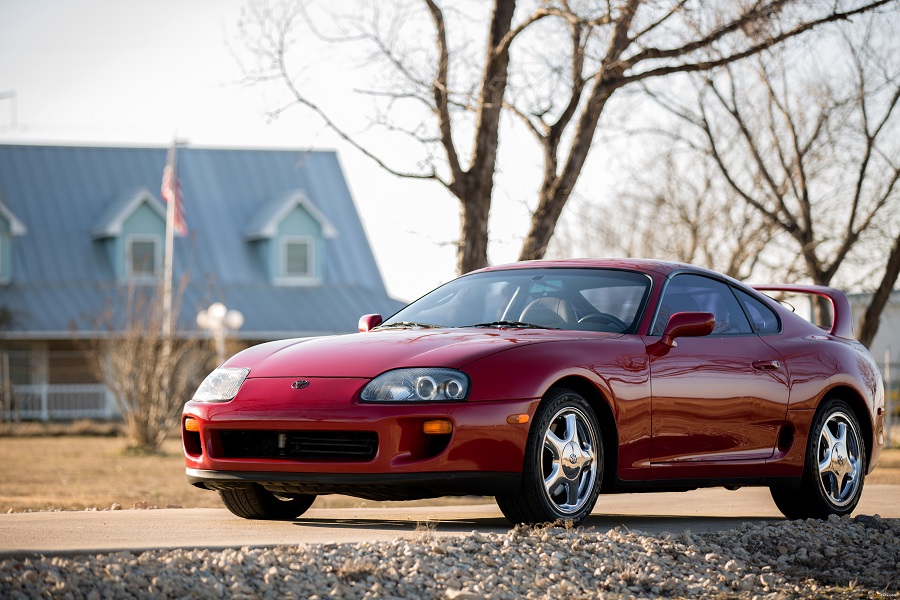
Toyota Supra
Pros: iconic engine, massive tuning potential.
Cons: skyrocketing prices.
The Mk4 Supra is a car that somehow hasn’t aged at all. It’s just gorgeous, isn’t it? The Dorian Gray of cars, it gets up to all kinds of hedonistic mischief and never gets a day older. Alright, perhaps the rims are a bit dated now, but hey they’re easily replaced. While prices are by no means cheap, its status and tuning potential is why it sits on our list of the best used cars to buy.
After an intense four years of development under the guidance of chief engineer Isao Tsuzuki, the Mk4 broke cover at the 1993 Chicago Motor Show, proving beyond all doubt how bullish the Japanese firms were about smothering the American market with their ballistic 2+2 supercoupés. Its sumptuous curves were unlike anything Toyota had marketed before, the design stunningly fluid and perfectly-judged. The hilariously tall rear spoiler was a statement of intent, while the figures of that hyperintelligent 2JZ motor really spoke for themselves.
As well as shoving a whole load more power into the Supra formula, the slinky Mk4 was actually shorter, lower and more svelte than the Mk3 it replaced, ably demonstrating that you can have more fun tinkering with the power-to-weight equation if you muck about with both figures. And while the car was, on paper, a sensible-ish four-seater boulevardier, its performance was enough to keep the supercars of the era on their toes. Period road tests demonstrated how the Porsche 911 Turbo 3.6 simply couldn’t keep up with it; the 2JZ straight-six was little short of magical, with 90% of its torque arriving at just 1,300rpm. And, despite the gentlemen’s-agreement claim of 276bhp, the real figure for the twin-turbo manual Supra actually began with a three. Quite simply, the Mk4 is a legend.
How much?
- $50,000-$130,000
- £30,000-£80,000
If you’re looking to scratch the JDM itch, check out our Toyota Supra Mk4 buying and tuning guide full of advice.
Best Used Hot Hatches
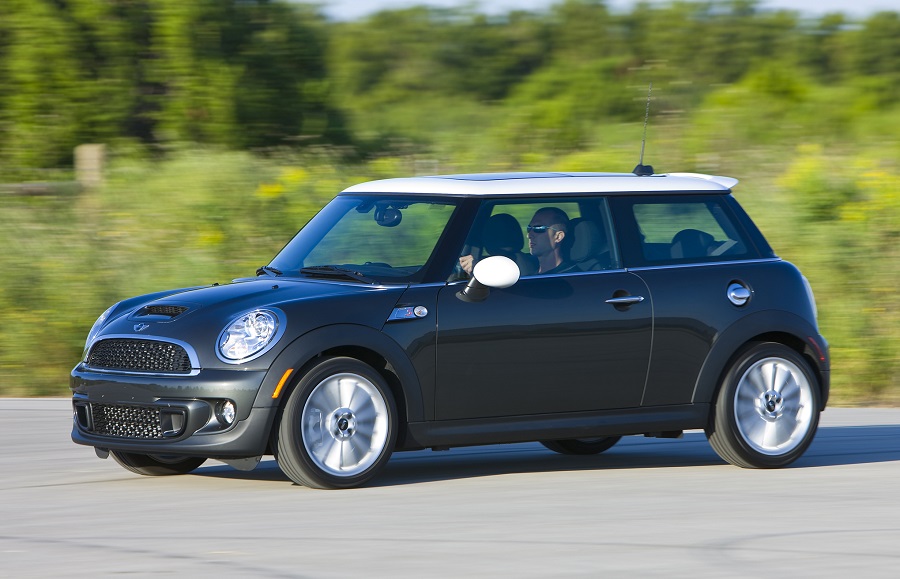
Mini Cooper S
Pros: quick, handles well.
Cons: mixed reliability reports.
Reveling in the runaway success of the first-generation R53 Cooper S, Mini made sure that when the second-gen model arrived in late 2006, the Cooper S version was one of the first variants available. As with the cooking R56 that served as its base, the Cooper S was largely more of a clever rework than a new model: on the outside, regs dictated it should have an 18mm taller shoulder line, but the R56 was also 60mm longer, meaning an extra 10 liters of boot space.
The biggest change was under the bonnet: the Peugeot/Citroen(PSA)-supplied ‘Prince’ N14 1.6-litre engine replaced the supercharged Tritec 1.6-liter engine. At launch, the Cooper S offered 175bhp and up to 192lb.ft, thanks to the overboost function whereby the turbo can boost above normal pressure for a short period. Vivid acceleration was the result: 0-62mph in just 7.1 seconds. And the upgrades weren’t just about speed – the cunning inclusion of the BMW VANOS system resulted in a combined fuel consumption figure of 40.9mpg, which did a lot to broaden this Mini’s appeal to hot hatch buyers who possibly hadn’t considered it before. The little R56 turbo tearaway was a hot hatch you bought with your heart and your head. And, if you’re dead set on wanting a supercharger, the older R53 is still very affordable as well.
How much?
- $5,000-$10,000
- £3,000-£8,000
Check out our R56 Mini buying guide for advice on what to look out for.
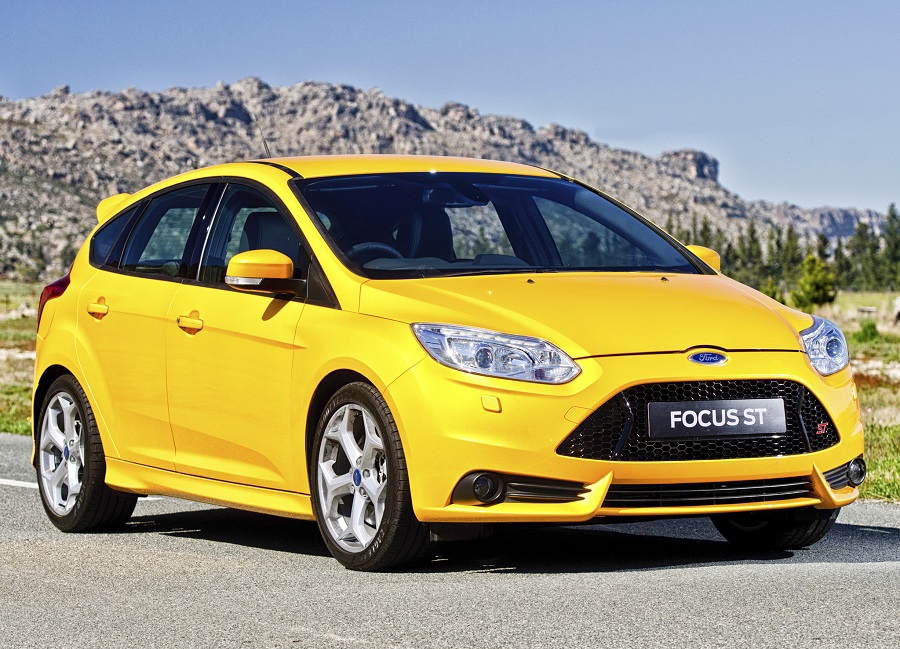
Ford Focus ST
Pros: quick, practical.
Cons: less capable than AWD rivals.
Need the practicality of a five-door hatchback, but still want to finish every journey laughing? The Mk3 Focus ST is a great option at this price point. Everyone loves a playful FWD hot hatch right? And with 250hp available from its 2.0-liter turbo four-banger, this thing is certainly that. 60mph arrives in just over 6 seconds, which is enough to make the kids throw up in the back, especially once you put its fine handling to the test through the twisty stuff. It’s not quite as accomplished as, say, a Mégane RS or Golf GTI on track, but on the road, it provides a great deal of driver feedback without being too harsh.
There are three trim levels to choose from when it comes to buying a Mk3 ST. Helpfully, their naming structure is quite intuitive to figure out, titled hierarchically as the ST-1, ST-2, and ST-3. Mechanically, they’re all basically the same, so you aren’t missing out on any performance by opting for an ST-1. As such, if you’re only fussed about how the car drives, save yourself some cash and buy a lower trim level. With the higher trim levels you’re simply paying for more tech, whether that be more intelligent headlights or an upgraded head unit, for example.
How much?
- $10,000-$25,000
- £8,000-£20,000
Read our Ford Focus ST Mk3 buyer’s guide here, if you like.
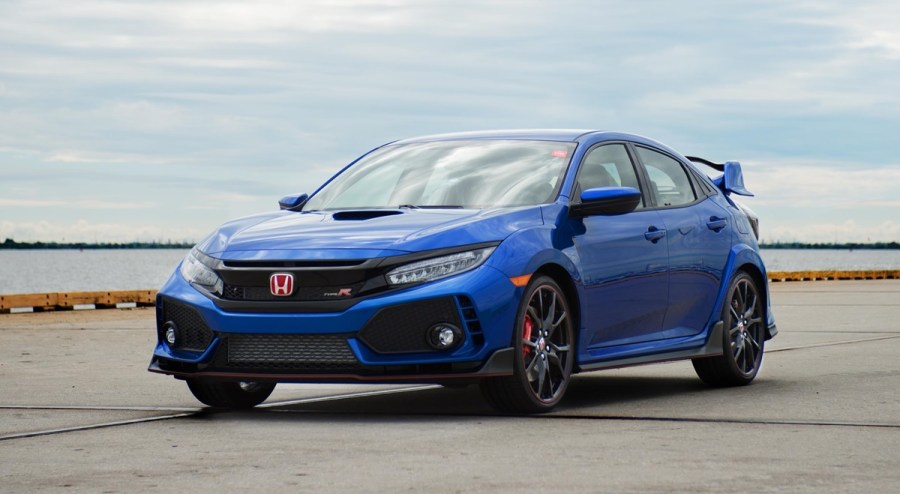
Honda Civic Type R
Pros: Potent engines, excellent handling, big tuning potential.
Cons: Divisive image.
It would be amiss of me to talk about hot hatches without giving a mention to the Honda Civic Type R. For decades, this nameplate has given us some of the best hot hatches to ever exist, whether it be the original EK9, bargain hero EP3, or exotic and rare FD2 (though I guess that one was a ‘hot sedan’, really). However, the generation I’ve selected for this shortlist is the FK8, not only because it’s arguably the most capable CTR of them all, but because it’s also the most globally available. Whereas the older Civic Type Rs are a common sight in Asia, Australasia, and Europe, Honda waited until 2017 to bring its flagship hatch to North America.
The FK8 is undoubtedly one of the best front-wheel drive cars ever produced. It handles its 320hp remarkably well (American market examples produce about 306hp instead), so well in fact, that around the Nürburgring Nordschleife it’s only two seconds slower than a Porsche 997 GT3! And if that’s still not enough performance for you, the vast Honda aftermarket has got you covered. After all, Civics are probably the most commonly modified cars in the world.
In fact, Honda seemed to lean heavily on this cultural status when designing the FK8, because from the factory it already looks like it’s been designed by teenagers. Some people love the aggressive look. Others find it a bit much. Whichever side of the divide you stand on will likely dictate whether you buy this car, because frankly if you were to judge it on its dynamic abilities alone there’d be no question about its suitability for a spot on your driveway.
How much?
- $27,000-$50,000
- £22,000-£35,000
Read our dedicated Honda Civic Type R FK8 buyer’s guide next.
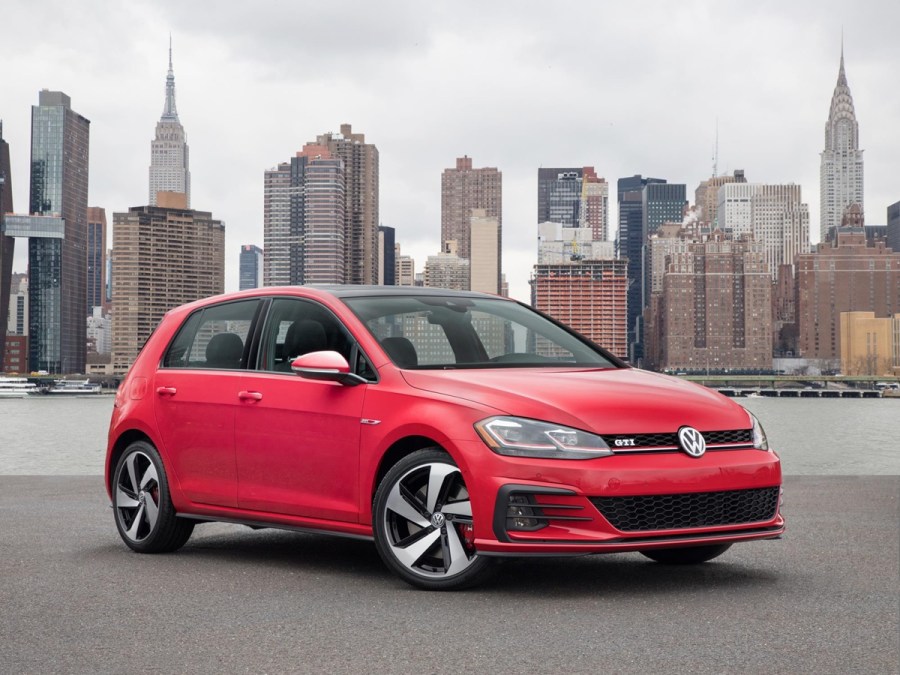
Volkswagen Golf GTI
Pros: Practical, quick, reliable, good tuning potential.
Cons: not the most charismatic hot hatch.
The Golf GTI is perhaps the Civic Type R’s closest adversary. Of the two, the Honda is more flamboyant, whereas the Volkswagen is more ‘grown-up’, but both cars provide the same result: a barrel of laughs when you drive them. Most VW connoisseurs would concur that the Mk7 Golf GTI is probably the best of the bunch, with the Mk5 coming in a close second. Out the box, the Mk7 feels more spritely than its quiet outward appearance might suggest, though horse for horse, it is down on power compared to the FK8 Civic. That said, 245hp is still more than enough for a fun daily driver. And, if you are a bit power hungry, it’s worth pointing out that the Golf’s EA888 engine is one of the darlings of the modern tuning scene.
Essentially, the Mk7 Golf GTI allows you to have your cake, and eat it too. It’s one of the most dynamically capable hot hatches of the 2010s, and comes without the sort of exterior styling that attracts unwanted attention. Not only that, but it’s available in either 3-door or 5-door guises, so if you do need space in the back for friends, kids, or pets, the Golf can be a surprisingly practical choice. The GTI nameplate is often touted as the benchmark for the hot hatch genre, and with the Mk7 it’s easy to see why.
How much?
- $12,500-$35,000
- £13,000-£24,000

Audi RS 3
Pros: all-wheel drive, fast, practical.
Cons: expensive, slightly numb handling compared to rivals.
Up until this point, all of the hot hatches we’ve featured have been front-wheel drive. After all, front engine-FWD is the classic hot hatch formula. However, in the past decade or so, a new breed of all-wheel drive hot hatches have raised the performance ceiling of the genre to a whole new level. With more traction, manufacturers can afford to give these cars more power, and as a result they’re far more rapid than they have any need to be. Stick an RS 3 Quattro up against a 996-gen Porsche 911, and I’d probably put my money on the Audi.
The RS 3 is a particularly interesting option from the AWD cohort. For a start, there’s a choice of two different body styles; the ‘Sportback’ 5-door hatch as pictured above, or a 4-door sedan variant. Plus, whereas most hot hatches have four cylinders under the hood, this Audi has a charismatic five-pot, which not only pulls like a train, but also has a very distinctive exhaust note. Anyway, why read about something when you can simply sit back and listen instead? Check out Matt’s hands-on review of the current-gen Audi RS 3 in the video below:
How much?
- $40,000-$60,000
- £25,000 (previous gen)-£65,000
Best Used Muscle Cars
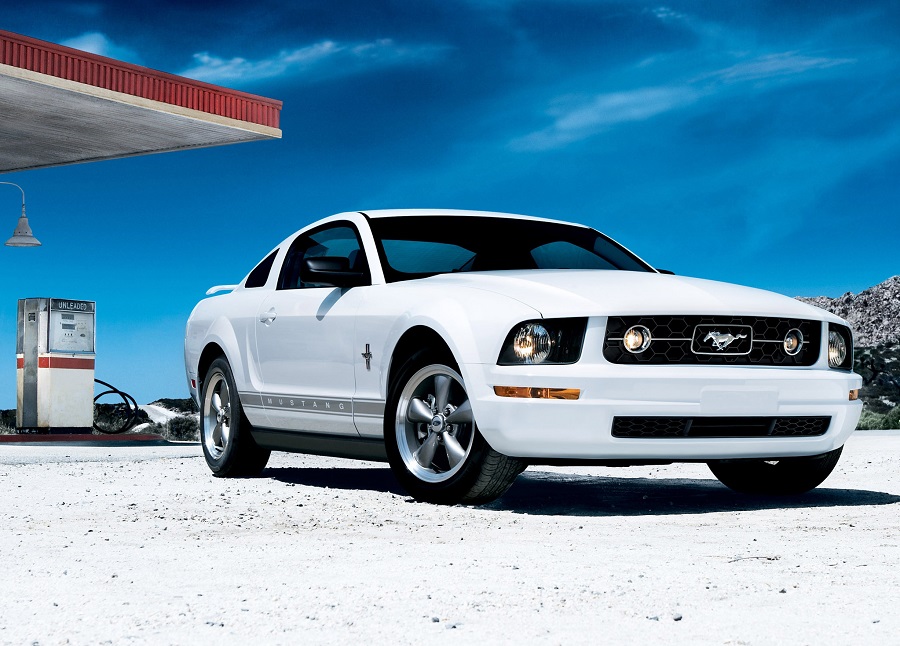
Ford Mustang
Pros: affordable, great engine.
Cons: handling can bite inexperienced drivers.
The world’s best-selling sports car, the Mustang has been an integral part of the motoring landscape since its big reveal at the New York World’s Fair in 1964. Indeed, the story of the ’Stang is a pretty incredible one: still available as a new model today, it’s America’s best-selling sports car of the last fifty years, and in late 2018 the ten-millionth Mustang rolled off the production line at the Flat Rock Assembly Plant in Michigan. It’s undeniable that the Mustang is a fundamental part of the cultural bedrock of the USA.
The S197-generation Mustang was a very well-timed car, arriving to the market in 2005 just as the world was enjoying a widespread retro renaissance – the New Beetle, the Mini, it was all old-school-new-rules and the fresh new Mustang fit right in. The S197 range started with the 4.0-litre V6 models, and that’s the version we’re looking at here. Standard equipment levels were high, with every car coming equipped with power windows and mirrors, power steering, remote keyless entry and twin-piston brakes, while the options list – as with any generation of Mustang – allowed buyers to go wild with the personalization. It’s a model that responds equally well to a light touch or the full Shelby-style glitz; there’s an elegance to the V6 Mustangs that’s ageing extremely gracefully, and they make for stylish and practical daily-drivers.
How much?
- $5,000-$10,000
- £8,000-£15,000
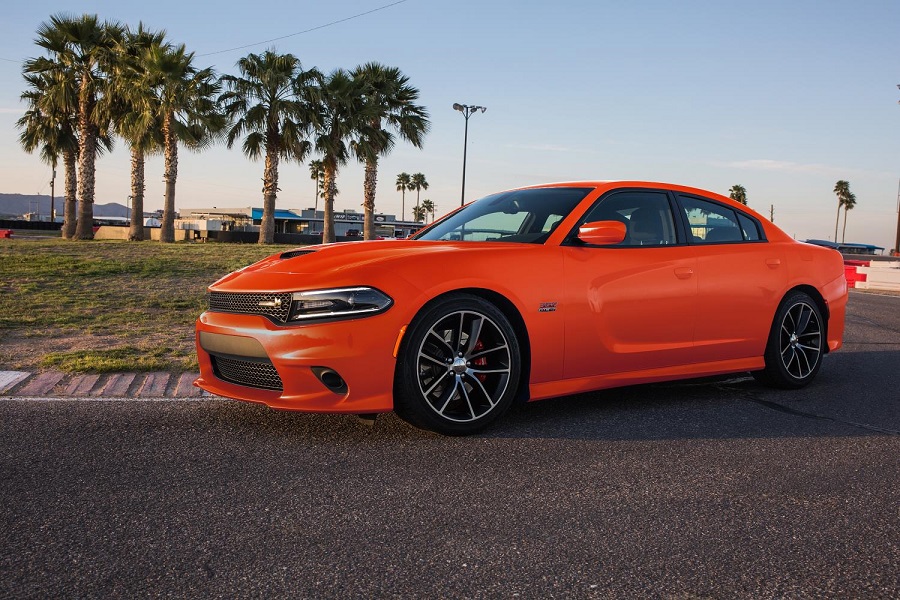
Dodge Charger R/T
Pros: big tuning potential, more practical than most muscle cars.
Cons: top specs are pricey.
The Dodge Charger is a lot of car for the money, as muscle cars tend to be. Unlike its Challenger counterpart (which by the way, would also have been a great shout for this list), the Charger multi-tasks as both a brawny straight-line speed merchant, and a genuinely practical daily driver.
Impressively, a budget of $25,000 will get you into the latest generation Charger (albeit a ‘new’ platform that’s been around since 2011), and there’s no need to settle for the base V6 cars either. For a proper Charger experience, we’d recommend the RWD R/T trim level; ideally, a post-2015 facelift model like the one pictured above. This refreshed sports sedan received better suspension, interior, and brakes over the pre-facelift version, not to mention heavily revised styling. At its core though, the important factor remained the same. Within that cavernous engine bay, the R/T holds a 5.7-liter naturally-aspirated V8 which produces just over 370hp and 395lb ft of torque. As such, 60mph arrives in 5.5 seconds.
So, just to re-cap, what you’re getting is a car which looks imposing, has plenty of space in the back, sounds excellent, goes fast, and is new enough to have all the sort of interior mod-cons a modern-day motorist might wish for. It’s hard to argue with that…
How much?
- $15,000-$55,000
- Only available via import outside North America.
Don’t fancy the Dodge? How about some of these other used muscle car options instead.
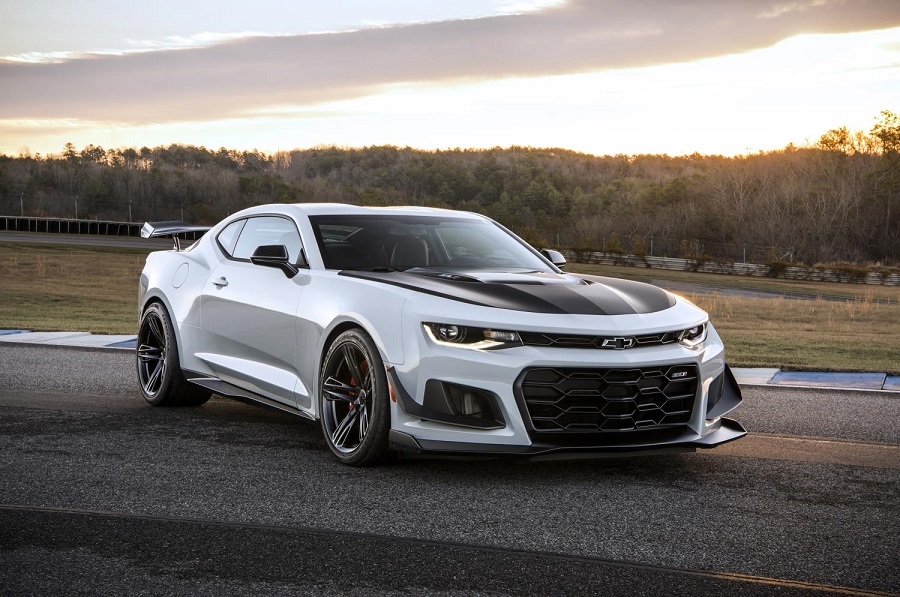
Chevrolet Camaro ZL1
Pros: combines big power with good handling.
Cons: expensive.
The Camaro has always been a strong presence in the muscle car scene, and the modern-era models are particularly brutal. Uncompromisingly huge with equally huge horsepower, these imposing coupes really are something special – and when the engineers came up with the ZL1 specification, all bets were off.
You see, there’s always been a bit of snippiness in certain quarters about the dynamic abilities of muscle cars – machines built to be devastating in a straight line, but fall to bits if you show them a moderate corner. But the ZL1 laughed in the face of all that. This was a muscle car that was built to handle. And as that’s never really been this type of car’s forte, Chevy threw a huge budget at it.
The ZL1 took the already-impressive Camaro SS and added Magnetic Ride suspension, wider wings to accommodate broader tires, improved front aero, and a carbon fiber bonnet insert to suck hot air out of the engine bay. And power? Ooh yes, there’s quite a lot of that. With 455bhp to play with, the ZL1 will run from 0-62mph in just 3.5-seconds, going on to a top speed of 198mph. and you could maybe top the double-ton if you keep the throttle pinned with a following wind. The 1LE package, meanwhile, adds all the sharp aero pictured on the car above.
It’s a wildcard option, but the hair-raising performance justifies its position on our list of the best used cars to buy. For something that costs under $100k, there won’t be many other cars that can deliver the same thrills for the same price. If for whatever reason you want something crazier, check out the Hennessey tuned ZL1 named The Exorcist…
How much?
- $50,000-$75,000
- £70,000+ – Given the ZL1 was never officially sold in the UK market, prices for these are far more expensive than in the US, unfortunately.
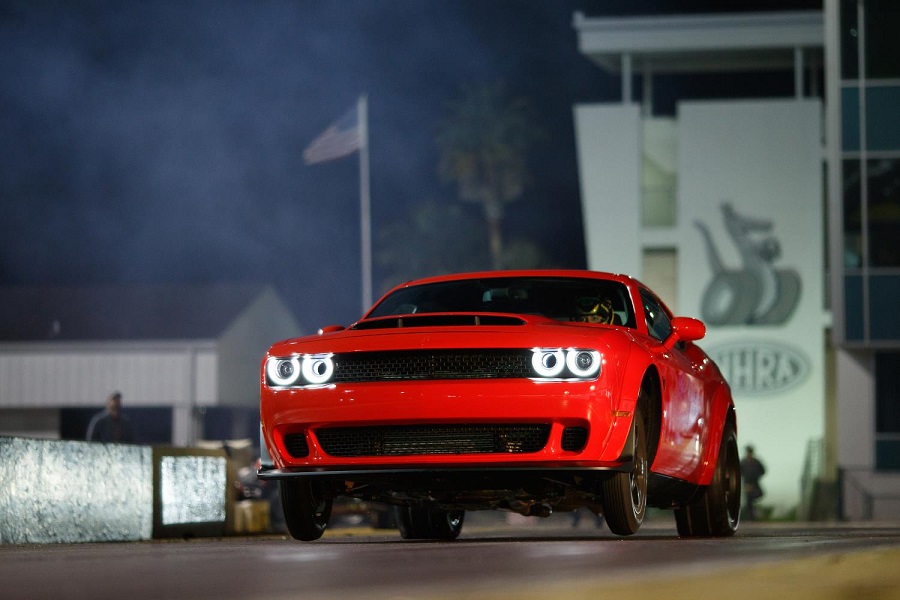
Dodge Demon
Pros: the best dragster you could buy direct from a manufacturer.
Cons: very expensive, not very multipurpose.
Let’s head back to 2018, where we find ourselves deep within the modern muscle car renaissance, with Dodge’s line of increasingly deranged Challengers and Chargers paying noisy tribute to their iconic names. The Hellcat of 2015 was a landmark model when it launched, with its outrageous supercharged 6.2-liter Hemi producing an almighty 707bhp… and if you thought the Hellcat was scary, the Demon really knocked things up a notch.
The ultimate variant of the modern Challenger, the Demon was a essentially a road-legal drag-racer that you could buy from a dealership with a warranty. Its 6.2-litre Hemi had a 2.7-liter supercharger on top, giving it a peak power figure of 808bhp on pump fuel. It’s a fun fact that the development team genuinely did design it to be a production car that could pull wheelies, and the specs made for beguiling reading: 315-section Nitto tires (on the front!), only one seat – unless you paid a dollar to add the other seats back in, a line-lock, and a ‘Power Chiller’ that hijacked the air-con system to pre-chill the intercooler. Quite possibly the angriest car ever built – not cheap either, but will undoubtedly hold its value as a collectible.
How much?
- $130,000-$190,000
- £140,000+
Best Used Convertibles
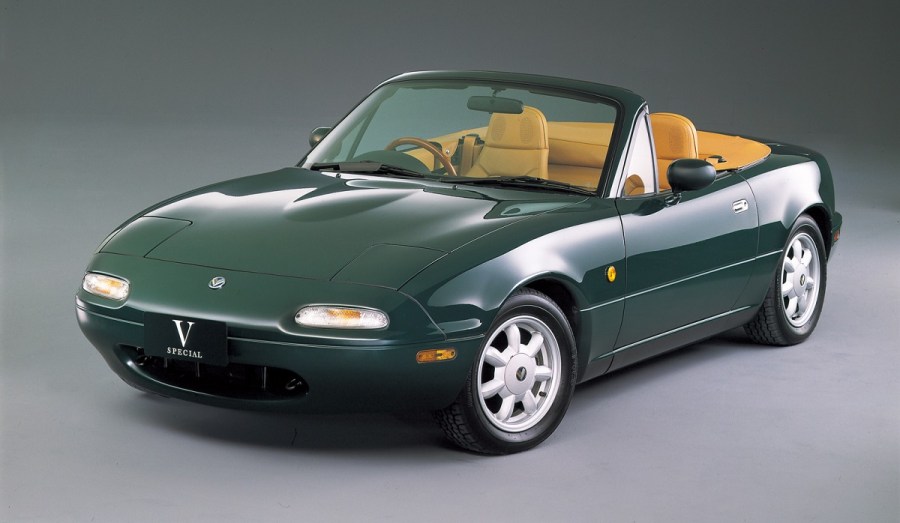
Mazda MX-5 Miata
Pros: great handling.
Cons: underpowered, can go rusty.
You knew this was coming right? Miata’s always the answer, as they say. Yep, if you want a cheap used convertible sports car, an MX-5 Miata has been one of the best options around for decades. It’s the first generation which is most coveted, not only for its adorably happy face and pop-up headlights, but because the general consensus is that these older cars are the most fun dynamically.
Now, it’s important not to get ‘fun’ confused with fast. Those two traits aren’t synonymous with one another, and the little Miata certainly isn’t the latter of those two things. Even with the post-1994 1.8-liter engine, these cars will only churn out 131hp. That’s not necessarily a bad thing though. It makes them the perfect platform for people learning how to handle rear-wheel drive sports cars, as the relative lack of speed makes them fairly forgiving. What’s more, even though they’re getting on a bit now, if you find a well-kept one, the engine should still be running strong.
Ultimately, if you’re an experienced car owner who wants the fully evolved package, the MX-5 Miata isn’t the car for you. But, if you’re looking for something cheap to get you started in the world of convertible sports cars, you can’t go wrong with one of these.
How much?
- $6000-$18,000
- £2000-£12,500
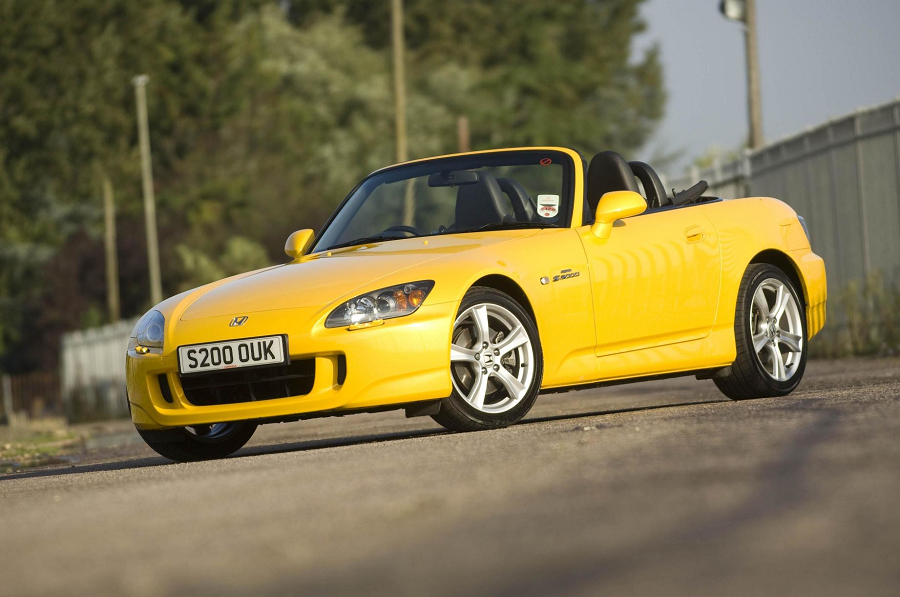
Honda S2000
Pros: brilliant engine.
Cons: rising prices.
The Honda S2000 is essentially an incredible engine with an elegant roadster wrapped around it. It’s a real screamer of a motor, a VTEC four-pot serving up 237bhp at a 8,300rpm, redlining at 9,200rpm, and featuring clever race-car tech such as forged pistons with ultra-low-friction skirts, and smart cam timing. There are few new cars that will hit a 9,000rpm redline, and even fewer that do it naturally-aspirated, it just had to feature in our list of the best used cars to buy.
The legendary S2000 enjoyed a ten-year production run. Designed from scratch to be a sporting convertible, Honda developed a chassis that was light and stiff, and the cleverness of the engine continues inside with a nouveau-retro digital dash, allowing you to observe the rapid building of revs in a colorful streak. And the body design is a work of stylistic genius – it’s pretty, but not ostentatious, so unless you know what you’re looking at, it can sneakily fly under most people’s radar. It’s basically a race car underneath, and no-one suspects a thing.
There were two generations: the AP1, from 1999-2003, introduced that iconic layout of F20C engine, 6-speed manual gearbox and Torsen LSD; the AP2 was a minor facelift built from 2004-09, with a variety of significant alterations. The AP2 had revised suspension to reduce oversteer as well as bigger wheels; spring and shock rates changed and toe-in reduced along with a softer rear ARB. The steering ratio reduced, and the subframe strengthened. A number of exterior changes signified the reworked model: oval tailpipes, redesigned bumpers, new headlights and LED taillights. But all S2000s are cool, we’d take any one of them.
How much?
- $18,000-$40,000 – Sadly for the US market, you won’t be able to get your hands on an S2000 without accident damage under $10,000. However, you can get something like a convertible Nissan 350Z or Pontiac Solstice.
- £8,000-£25,000
Want more information? We’ve got a dedicated Honda S2000 buyer’s guide just for you.
Best Used Wagons
Volvo 850 R
Pros: very practical, gutsy engine.
Cons: getting very old now
Let me start this next little segment by throwing a bit of shade. If you recognize the 850 R, you’ll probably know about the time when Volvo turned the 850 wagon into a race car to compete in the British Touring Car Championship. That was back in 1994, and it’s still fondly referenced today. However, what most people fail to mention, or realize, is that the 850 Wagon super tourer was actually a bit crap. Results only picked up once Volvo switched to the 850 sedan in 1995. Fortunately though, unlike the race car, the roadgoing Volvo 850 R estate (or station wagon depending on where you are in the world) is nothing short of fantastic.
The highlight has got to be its charismatic five-cylinder engine, which from the factory outputs just shy of 250hp, and sends those ponies to the rear wheels. That translates to a 0-60mph time of less than 7 seconds and a top speed of 155mph. For a late ‘90s station wagon, that’s insane. It does look pretty good too, in a boxy kind of way. Compared to a regular humdrum 850 you’ll notice little styling cues such as bigger alloy wheels and minor bodywork aero, but it’s all very tasteful. This modest modern classic is the sort of car that most people – maybe even some car enthusiasts – won’t bat an eyelid at. But if you know, you know…
How much?
- $7,000-$20,000
- £6,500-£15,000
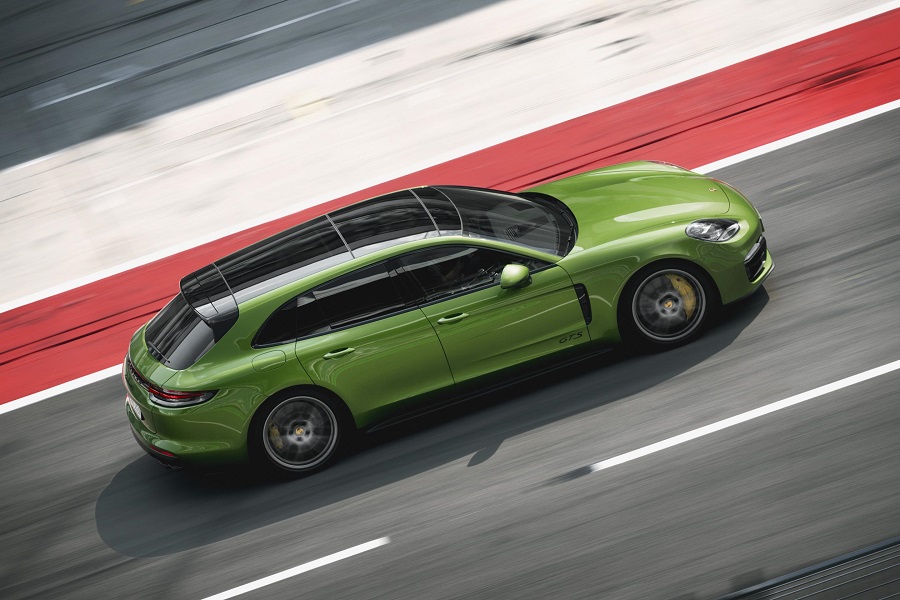
Porsche Panamera
Pros: ultimate blend of performance and practicality.
Cons: very expensive.
There comes a point in life where all of a sudden the Porsche Panamera starts to make sense. When you’re a youngster, it just doesn’t appeal – certainly not when stood next to a 911. But then, all of a sudden you stop viewing it as a slightly ungainly looking car for the middle-aged, and start to realize its potential. See, if you want a car that can genuinely do it all, don’t get an SUV. Get one of these.
The spec which appeals most to us is the GTS. We’ve featured the 911 GTS in a review on the site, and as you’ll find out if you give it a read, it left Matt feeling rather enamored. In the 911, the GTS package offers arguably the perfect blend of performance and comfort, so to see that concept translated across to what is essentially a station wagon, is pretty special. Its 4.0-liter twin-turbo V8 engine generates a peak output of 453hp and 457lb ft of torque. An 8-speed PDK dual-clutch transmission then sends that power to all four wheels, which rockets you to 60mph in 3.9 seconds. It’s not just a ‘point and squirt’ kind of car either. Don’t get me wrong, it’s a bit of a barge, but for a barge it handles impeccably well thanks to a low ride height and air suspension fitted with adaptive dampers.
The real party trick of the Panamera is indeed its size though. If you wish, it can genuinely serve as a family car when you’re not touring across the country at pace for business. That’s what I love about it – its cavernous interior, adept chassis, and badge-worthy powertrain make this car a real master of all trades.
How much?
- $100,000-$170,000
- £75,000-£140,000
Best Used SUVs
Jeep Wrangler
Pros: commendable off-roader.
Cons: mixed reliability reports.
Aside from perhaps the Land Rover Defender, if you ask someone to mentally picture an off-roader, they’ll probably picture the Jeep Wrangler. It’s been a favorite amongst overlanders and trail enthusiasts for decades thanks to its rugged durability and unique aesthetic.
We’re particular fans of the Mk3 or ‘JK’ generation, which added a little bit more user comfort to the ultra-focused all-terrain package. That’s not to say its off-roading abilities are any less impressive than its predecessors though. You’ll still regularly see Mk3 Wranglers being used within the off-roading community thanks to their good ground clearance (8-10 inches depending on spec) and tough Dana 44 axles. All Mk3 Wranglers get those at the rear, and the Rubicon also gets the ’44 at the front. Other specs make use of the Dana 30 at the front. So essentially, they’re built robust.
You can also choose from longer-wheelbase four-door body styles, or shorter-wheelbase two-doors. A longer wheelbase example will suit those of you who value interior practicality. Plus, they’re also less likely to tumble over. On the other hand, the shorter wheelbase variants are great for activities like rock crawling as they’re less likely to bottom out. The shorter Wranglers naturally have a better turning radius too, which can prove useful in difficult terrain.
Plus, the Wrangler aftermarket is massive, so if you do want to try and improve upon what Jeep created, there’s a whole host of specialist companies out there willing to help you on that journey.
How much?
- $12,500-$70,000
- £12,000-£50,000
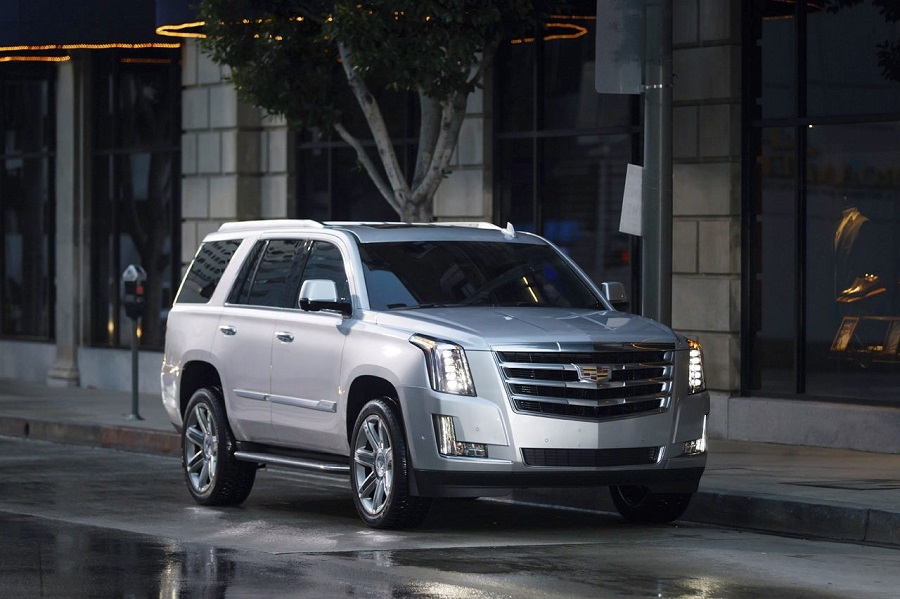
Cadillac Escalade
Pros: practical, luxurious
Cons: expensive, no good off-road.
The Cadillac Escalade is very much on the opposite end of the SUV spectrum. I wouldn’t advise taking this urban cruiser through the depths of any National Parks, instead its much more at home on the busy streets of New York or D.C. It’s a car which exudes a certain amount of authority, often associated with high-ranking businesspeople or government officials, and as such it comes with a fair chunk of street cred. Sure it might not be as fashionable amongst rappers and NBA players as the G-Wagon or Urus is these days, but once upon a time it was SUVs like the Escalade and Lincoln Navigator which were the prized possessions of pop culture’s finest. While the Escalade may have traded in some of its star power for a more inconspicuous reputation in modern times, it certainly hasn’t lost any of its luxury appeal.
The fourth-gen Escalade (pictured) comes with a 6.2-liter V8 as standard, connected to an 8-speed auto ‘box, or a 10-speed in 2018+ examples. It can seat up to eight passengers in business-class comfort and at the time of its release was one of the structurally safest SUVs on the market. So, if you’re looking to coast along the streets in style with up to seven of your closest friends and/or family members, there aren’t many cars better equipped for the job.
Interested in diving deeper into the SUV genre? Check out some more of the best used SUVs you can buy today.
How much?
- $30,000-$60,000
- Not available in the UK unless imported.
Best Used Pickups
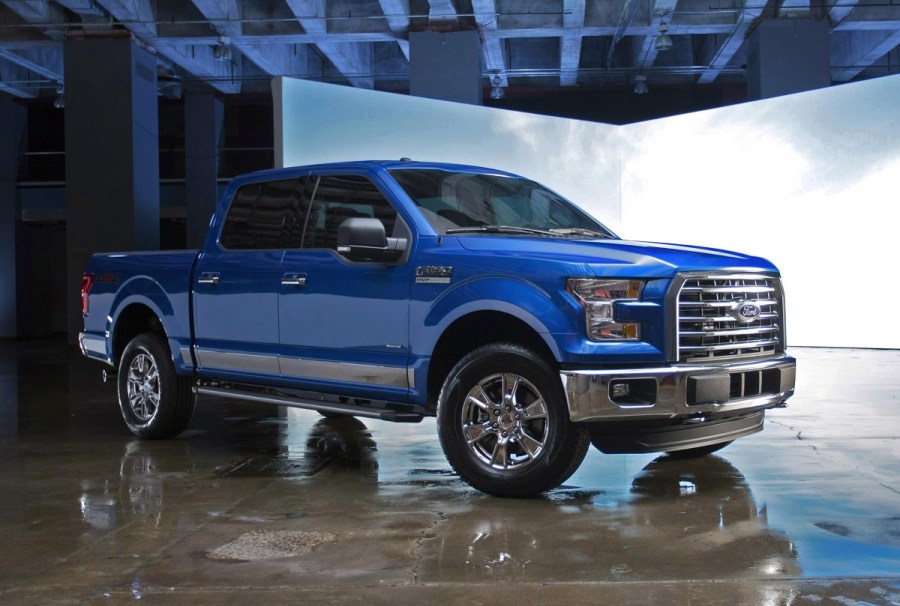
Ford F-150
Pros: practical, reliable, plentiful.
Cons: expensive to run.
The 13th generation Ford F-150 was met with initial raised eyebrows, given that it bore a body made almost entirely of aluminum. The concern was that it’d be too easy to scratch and dent, but that didn’t stop the American public from buying them in their droves. Fast forward to 2023, and those initial worries haven’t really panned out into reality. In fact, consult the forums and you’ll find owners brandishing their aluminum trucks with praise about how the bodywork is holding up. On top of that, the 750 pounds saved by switching from steel to aluminum has allowed F-150 owners to enjoy better fuel economy. As such, this relatively modern iteration of America’s favorite pick-up truck represents a great used market option.
As far as specs go, if you opt for the 13th generation, you’ll be able to choose from three different V6 engines ranging from 2.7 to 3.5 liters in capacity, or a full-fat 5.0-liter V8. There are also seven different trim levels and the option of rear-wheel drive of four-wheel drive. The Standard, SuperCab and SuperCrew body style variations allow you to choose whether you want something more compact, something with more interior space/seating, or a larger bed, respectively. Essentially, whatever job you have in mind, you can find an F-150 that’s tailored for the role.
How much?
- $15,000-$60,000
- Not available in the UK unless imported.
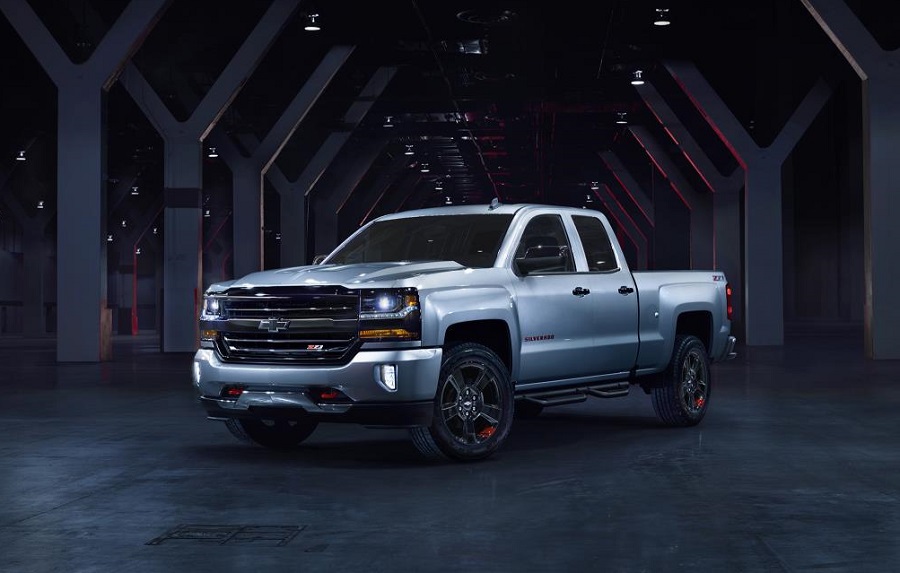
Chevrolet Silverado
Pros: practical, reliable, plentiful.
Cons: expensive to run.
I couldn’t talk about the F-150 without mentioning its arch rival, the Chevrolet Silverado. In this instance, it’s the third-gen Silverado that we’ve chosen, built between 2014-2018. Compared to the aluminum F-150, the steel-bodied Silverado is a bit more old-fashioned in its construction, but to you that might not be a bad thing if you’re more comfortable with the traditional way of pickup truck design. That’s not to say the mk3 Silverado is a dinosaur though. Although the materials may be familiar, the body and frame were completely fresh concepts and the overall package went down very well indeed. So well, in fact, that the Mk3 Silverado won North American Truck of the Year in 2014.
The Silverado’s V6 option pales in comparison to the six-pots offered by Ford though. Instead, if you want the best Chevy experience, we’d advise opting for the 5.3 or 6.2-liter V8. Those power units produce 355 hp/383 lb ft and 420hp/460lb ft respectively. It’s also worth noting that if you enjoy a bit of added luxury, be sure to check out the GMC Sierra. Being a GM product, the Sierra has the same structural and mechanical DNA as the Silverado, yet you’ll find its interior is that little bit more welcoming in 1500 Denali spec.
How much?
- $10,000-$35,000
- Not available in the UK unless imported.
Want to view more of vehicles like these? Have a read of our guide to the best used pickup trucks on today’s market.
Best Used Luxury Sedans
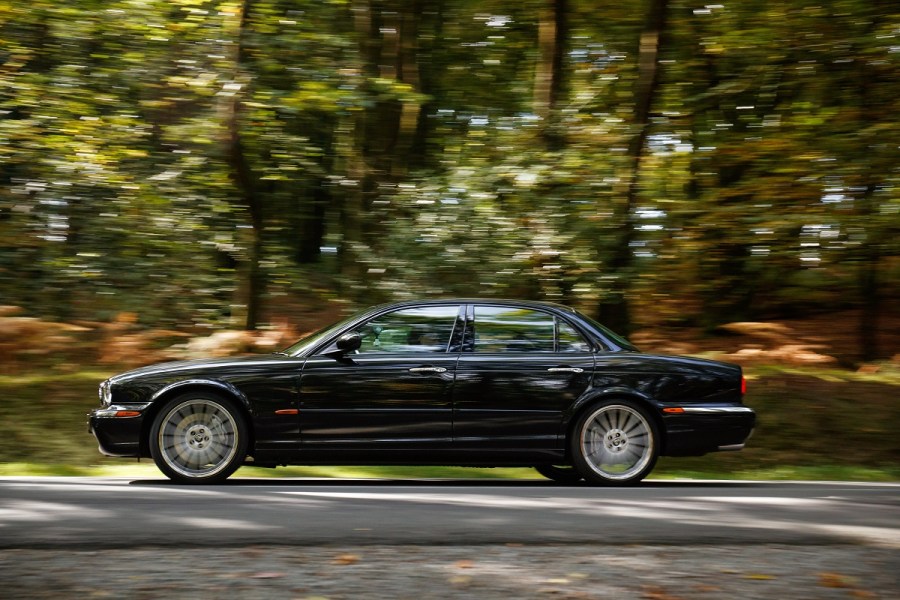
Jaguar XJ
Pros: luxurious, handles surprisingly well.
Cons: mixed reliability reports.
Don’t be fooled by its rather ‘traditional’ styling, the X350-generation Jaguar XJ was an innovative, state-of-the-art car when it launched in 2003. The big headline was its all-aluminum monocoque, which came about as a way of increasing its cabin space, while simultaneously keeping the car’s kerb weight down. As a result of this, plus Jaguar’s renowned ability to produce cars which handle well, the XJ is surprisingly responsive to drive. The V8 petrol engines are the pick of the bunch too, offering bursts of power that verge on addictive.
More than anything though, this car excels at creating an aura of luxury whenever you get behind the wheel of one. The seats are wonderfully comfortable, and it’ll calmly sit in the fast lane without causing much of an audible stir. Even the automatic gearbox is lush and smooth. Everything just feels easy when you’re behind the wheel of the XJ, so much so that you almost begin to pity the fools that you pass by, trundling along in their feeble commuter cars. So, while it might bring out the worst of you as a person, there’s no doubting that the Jaguar XJ is one of the best value-for-money used luxury sedans out there.
How much?
- $6,000-$25,000
- £2,500-£20,000
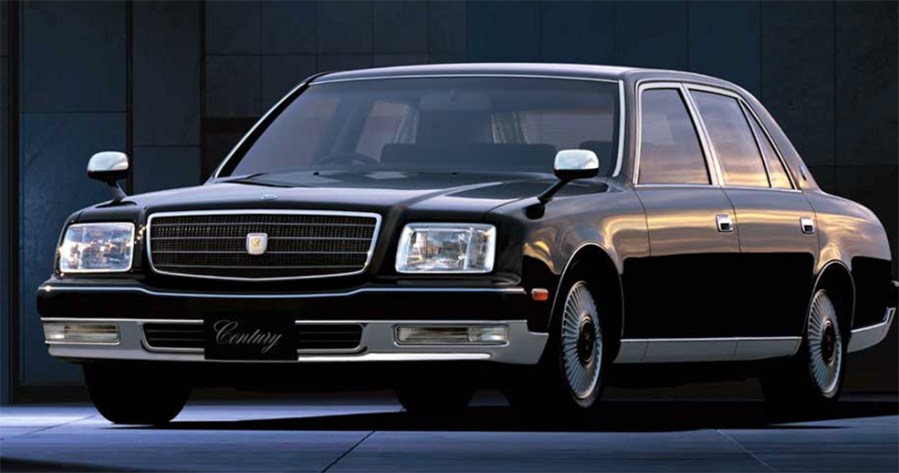
Toyota Century
Pros: very luxurious.
Cons: hard to source.
If you like your luxury sedans to be visually understated, yet opulent on the inside, then the Toyota Century is a great shout. For decades, the Century has been the ultimate car for wealthy Japanese businesspeople who prefer to sit back and let their chauffeur handle the busy expressways. Intended only for the Japanese market, the rest of the world soon caught on to the Century’s merits, and as such a small import trade has emerged for Century enthusiasts who have become enamored with the car’s exotic stature from afar.
So, what’s all the fuss about? Well, let’s start with the powertrain, shall we? Under that unassuming hood, you’ll find a 5.0-liter V12. Early examples of the G50 generation (as pictured) came with 4-speed automatic gearboxes, though in the mid-2000s that was upgraded to a 6-speed. The power delivery is silky smooth, meaning that inhabitants of the rear seats can make full use of the recline and massage functions. The front passenger seat even opens up to allow the person sitting behind it to stretch their legs out, should they wish. Ultimately, this isn’t a car to flaunt wealth, but instead is a car for people to privately enjoy the luxury that their hard-earned money buys. A used one of these would also make for the ultimate VIP build.
How much?
- $15,000-$30,000
- £17,500-£25,000
Best Used Electric Cars
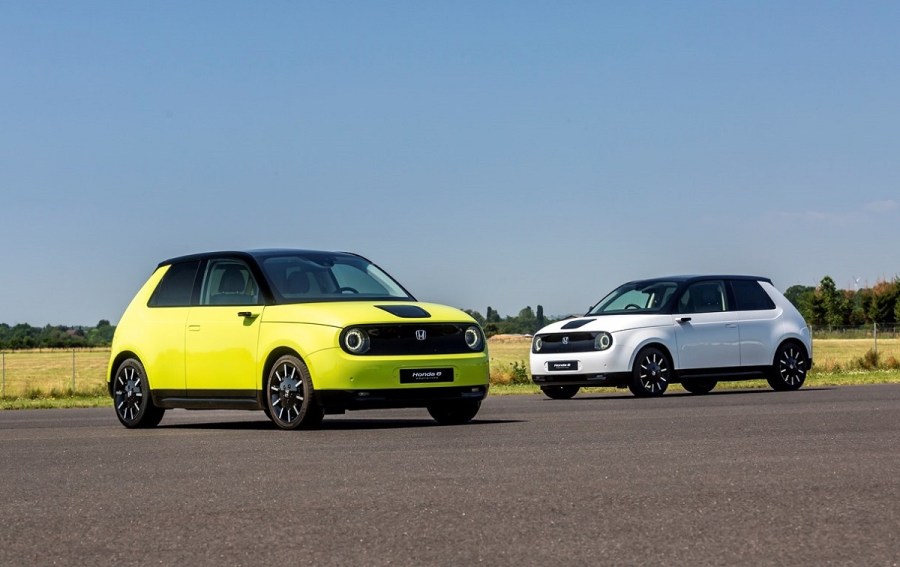
Honda e
Pros: lovely interior, fun styling.
Cons: range only suitable for short urban commutes.
From the offset, it’s important to note that the Honda e does have its flaws. The biggest is its range. From a full charge, you’ll only manage to cover 131 miles before the battery runs flat. For regular long-distance commuters, this one isn’t for you. For those that live in the city, the appeal is much, much higher. When you’re only doing short journeys around town, those 131 miles will last surprisingly long. And what this car lacks in endurance, it more than makes up for elsewhere.
First of all, there’s the aesthetics. I appreciate that it’s not going to be everyone’s cup of tea, but in my eyes, the Honda e is a delightful blend of futuristic and retro styling cues that looks like nothing else on the market. Inside, I genuinely believe the Honda e has one of the best car interiors of the 2020s so far. To drive, it’s not a total go-kart, but it’s nippy enough to feel fun.
However, the best part by far is how much these things are depreciating. Well, that’s not great news if you’re an original owner, but if you’re the buyer, you should be rubbing your hands in glee. The lower end of the Honda e market in the UK starts at £16,000-£17,000. But for that, you’d be getting a three-year-old car with around 25,000 miles on the clock. Take into account that new, these are £38,000, all of a sudden, a used Honda e looks like a smart deal for urban drivers who want a new EV, but can’t afford the asking prices. There is some bad news though. The Honda e isn’t available in the US, so this tip is only for our European readers. Sorry folks!
How much?
- £16,000-£32,000
- Not available in the US.
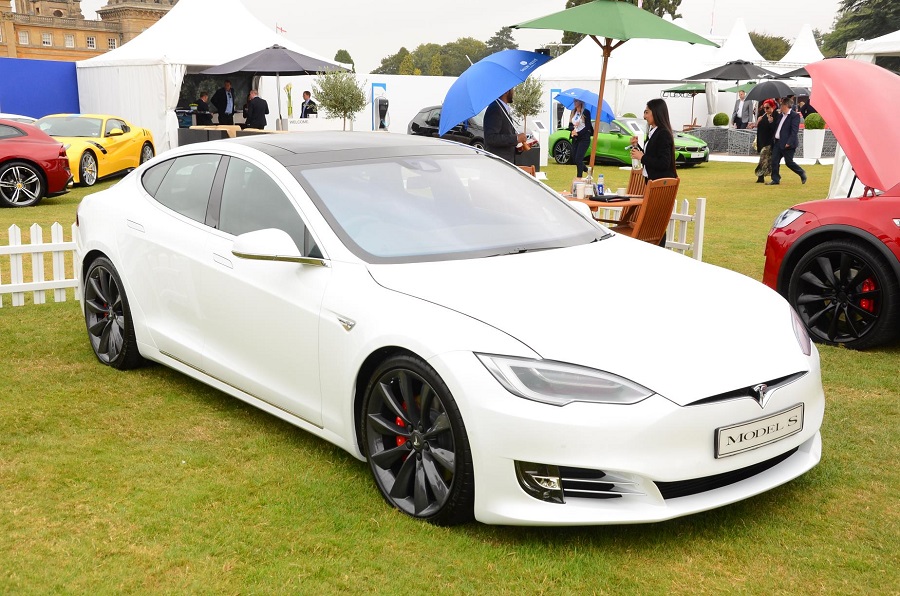
Tesla Model S
Pros: very quick, good range.
Cons: build quality.
There are plenty of reasons why you *wouldn’t* want to buy a used Tesla. For one, the build quality is a stick that people have been bashing Tesla with for years. Then there’s the whole problem with image. Tesla is synonymous with Elon Musk, and as Twitter (now X) has proven in recent months, that’s not an association that does a brand huge favors. Or maybe it’s much simpler than that – maybe you wouldn’t buy one simply because you don’t like electric cars.
Despite these downsides, there is a case to be made for the Model S. So here’s my attempt at making it…
Put simply, if you want a premium EV experience without splashing out on something new from a better-renowned brand, the Tesla Model S is the best option there is. This luxury sedan popularized electric cars amongst the wealthy when it launched in 2012, and since then it’s had numerous revisions. Six different dual-motor powertrains have been and gone in that time, the best of which being the P100D (not including the ‘Plaid’ cars which are out of budget).
If you can find one of those in budget, which should definitely be doable at this price point, you’ll get a practical sedan with 589hp and 920lb ft of torque on tap. In ‘Ludicrous Mode’, that translates to 0-60mph in just 2.3 seconds – which frankly is bonkers for a car of this genre. Plus, if range is a concern that you have with EVs, you can rest easy knowing that the P100D offers 315 miles from a full charge, though you can also buy a Long Range variant which will do an impressive 405 miles in one go. Even better, Tesla also offers the best charging infrastructure in the world.
How much?
- $20,000-$100,000
- £20,000-£65,000
Best Used Grand Tourers
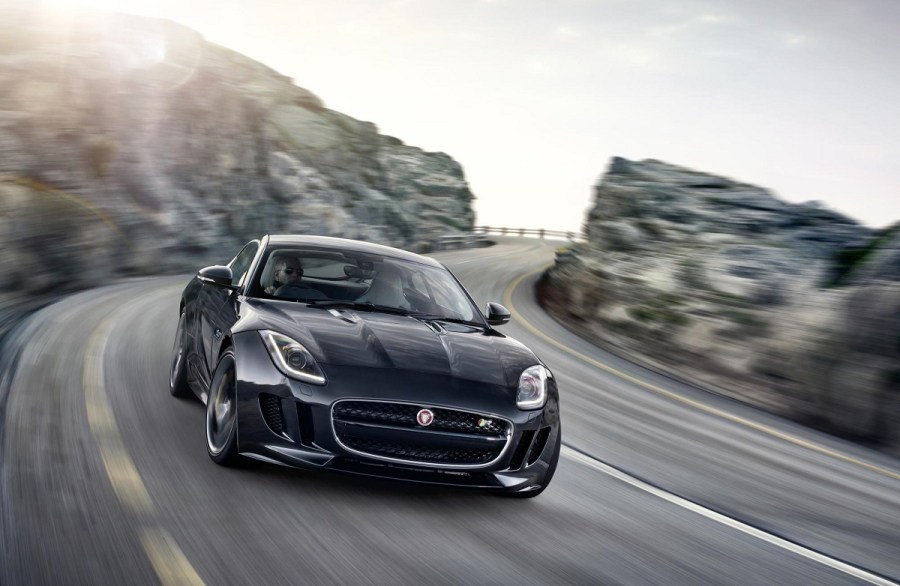
Jaguar F-Type
Pros: great engine options, looks superb.
Cons: expensive to run.
For a car so beautiful, so sonically emotive, and so dynamically adept, the Jaguar F-Type really isn’t spoken about enough. Perhaps it’s because people are scared of anything associated with JLR’s quality control, or perhaps it’s because it’s simply easier to buy something German. Whatever the reasoning might be, I think that the F-Type is deserving of more plaudits. So here I am, throwing plaudits around all over the place.
Let’s begin with the powertrain options. You could get a four-pot, interestingly, but why would you when there are a magnificent selection of V6s and V8s to have instead. Both motors will soak up the long-distance miles without much fuss, and yet, both are able to supply ample gusto for when you fancy getting a spirited on a back lane. Both sound utterly sublime too. As for the handling, the F-Type is a more competent beast than its stocky proportions might suggest, but don’t expect it to feel as lithe as a Cayman. It’s more of grand tourer than an outright sports car, as is reflected by the plush, comfortable interior.
But the options don’t stop there. You can have a manual gearbox, or an automatic. You can have a hardtop coupe, or soft top convertible. Whatever blend of style and substance you want from your GT, the F-Type can provide. There is a newer, facelifted version too, but for the most part there’s nothing substantial to right home about there beyond its reworked jawline. For that reason, we’d go for the older cars. They’re a cheaper used alternative and arguably even look a bit better, as well.
How much?
- $25,000-$80,000
- £20,000-£60,000
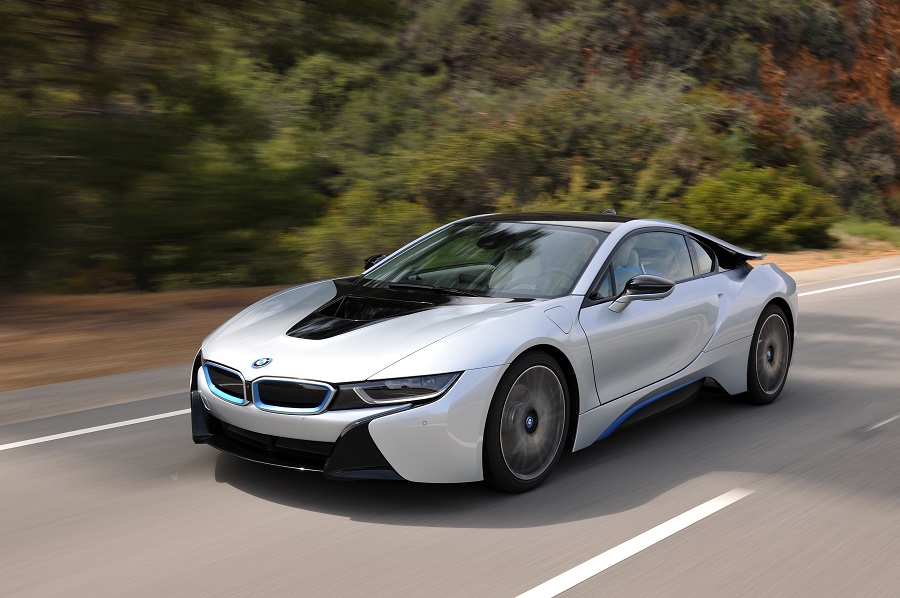
BMW i8
Pros: clever powertrain, looks superb.
Cons: handling isn’t as sporty as you might hope.
To properly appreciate this car, first you must understand that despite its looks (and what a looker it is, by the way), this is not a supercar. It was never meant to be, and it’s unfair to judge it as one. No, instead, this is a luxurious GT – it’s a car to enjoy driving in, just not necessarily at ten tenths.
If you’re familiar with BMW’s naming strategy, you won’t be surprised to hear that the i8 is electrified. Specifically, it’s a plug-in hybrid, with a lithium-ion battery mated to a three-cylinder petrol engine sourced from MINI. That results in a combined range of around 350 miles, and 20-30 of those can be spent running on electric propulsion only. Power-wise, you’re looking at 369hp, which these days is nothing to write home about on paper. But, in practice, the package works brilliantly.
It’s got an excellent driving position, from which you can enjoy a relaxed and peaceful version of motoring, all the while sitting in an interior that actively makes you feel good. Then, when you do want to get the pulse racing a bit, its characterful (albeit synthesized) engine and lightweight chassis will allow you to soar through back roads with great precision. It can be playful if you want it to be too, assuming it’s still on standard-width (relatively thin) tires. Oh, and did I mention it’s quite pretty?
How much?
- $50,000-$100,000
- £35,000-£70,000
Best Used Supercars
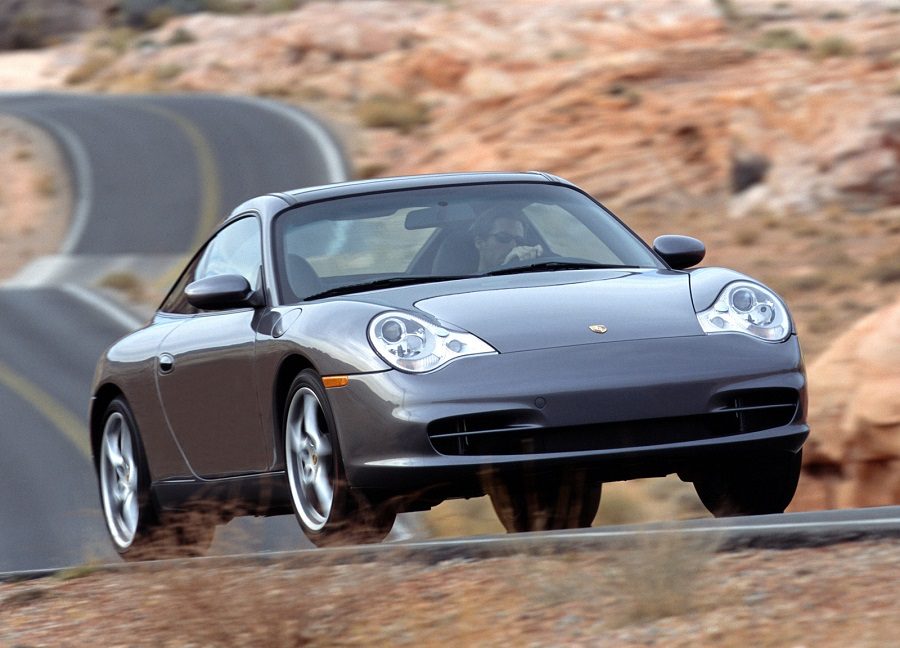
Porsche 911
Pros: (relatively) affordable, good engine, good handling.
Cons: controversial styling.
The cult of the Porsche 911 has been peaking petrol heads’ attention of all ages for generations. And for good reason, too, hence its position in our list of the best used cars to buy. Let’s explain.
In the 2020s, the 1990s/2000s-era 996 has become a very much sought-after modern classic. It may have suffered a few brickbats when launched, thanks to the fact that it shared its front end (and its so-called ‘fried egg’ headlights) with the more affordable Boxster. And the evolution of the model that really irritated the purists at this stage was that its engine was water-cooled; this was the first 911 generation not to have an air-cooled flat-six, and that rather upset the applecart.
The 996 suffered further ignominy in later years when its name became synonymous with forum ‘experts’ banging on about the infamous IMS issue, whereby the engine’s intermediate main shaft could fail unexpectedly and lunch the engine. But by now it’s fair to say that the vast majority of cars will have had this sorted, leaving the 996 as an affordable and properly usable sports car – and this misplaced reputation is what’s keeping prices low. They really are fabulous cars too; beautifully engineered, built for fun, and very pretty.
Clever buyers will note that, while values of the Turbo, GT3, GT2 and RS models are becoming increasingly massive, the lower-echelon Carrera models are surprisingly inexpensive. The Carrera 4 has an excellent spec, with all-wheel-drive, clever differential braking, and a 300bhp 3.4-litre flat-six. You could use it every day, and it costs less than a new hatchback. Bit of a slam-dunk really, isn’t it?
How much?
- $18,000-$35,000
- £12,000-£30,000
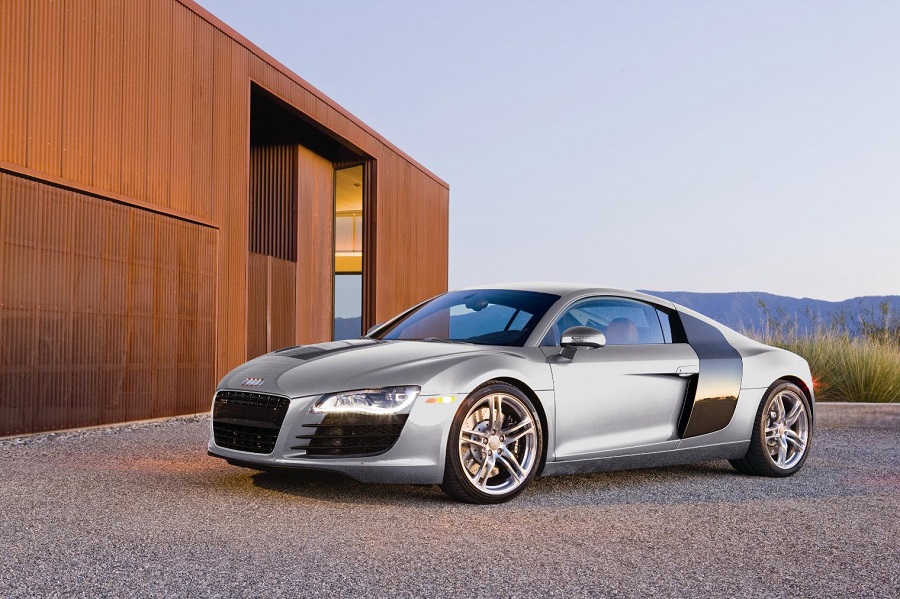
Audi R8
Pros: good handling, iconic styling.
Cons: V10 isn’t as good as V8.
An inevitable future classic if it isn’t one already, the first-gen Audi R8 would be high on our shopping list if someone cruelly forced us to buy a used supercar. For a start, they still represent shocking value, especially if you follow our advice and opt for the “lesser” 4.2-liter V8 rather than the 5.2-liter V10.
Truth be told, when the R8 first launched, it was a bit of a shock to the system. Until the R8, Audi’s high-performance models had never truly wowed people with the way they handled, but that all changed when the Ingolstadt brand built this heavenly mid-engine supercar. To match its sublime handling, it was blessed with a 4.2-liter V8 that produced 414hp, and although it utilized Audi’s Quattro AWD system, up to 70% of that power could be sent to the rear wheels. That gave the car a wonderful RWD-esque feel on the limit, while still offering better grip and stability than its true RWD rivals.
Sadly, although the alternate Lamborghini-sourced V10 engine was a nice idea, its dimensions and placement affected the car’s weight distribution slightly, and that in turn eroded some of the poise and balance that served the V8 R8 so well. It does sound pretty epic though. Plus, Audi also offered the Mk1 R8 as a Spyder convertible, so if you enjoy feeling the wind and bugs flow through your hair, that’s another tick in the box.
How much?
- $60,000-$200,000
- £30,000-£85,000
If that introduction’s piqued your interest, feel free to have a read of our Audi R8 Mk1 buyer’s guide.
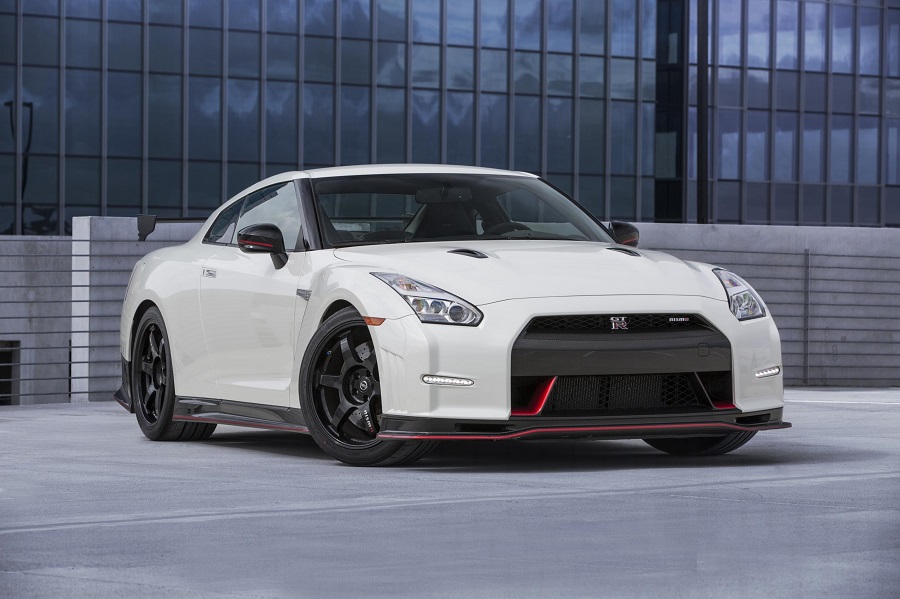
Nissan GT-R
Pros: good handling, massive tuning potential.
Cons: Lacks the wow factor of other supercars.
A sharp departure from its Skyline-based predecessors, there’s no whiff of humdrum sedan about the R35-gen Nissan GT-R. Debuting in the mid-2000s, this car heralded the launch of the GT-R as a stand-alone model with its own bespoke platform. Consequently, all sorts of rumors emerged from the depths of Japan about this new breed of Godzilla. All of a sudden, people were gossiping about its ‘un-hackable’ ECU, its nitrogen-filled tires, its lab-grown engine. And then, when it arrived, the grandeur behind the gossip all made so much sense.
Able to take on supercars and win, the R35 GT-R was one of the most impressive vehicles to come from the noughties. And because it was a Nissan GT-R, it had a different sort of street cred that regular supercars just didn’t have. That reputation stemmed from its predecessors’ heroic status within the modified and tuning scene, and so it didn’t take long for said tuners to get busy with the R35. Eventually, some of the myth around the car faded in the face of reality. That ‘un-hackable’ ECU was indeed hackable, and once you complement a remap with some heavily beefed-up internals, the VR38 engine will happily take you to 1000hp and beyond. If you want to build an unbeatable weapon for the track, the GT-R is one of your best options for a canvas, not least thanks to its hugely plentiful aftermarket.
Of course, if you want to keep things stock, the standard GT-R is still a special vehicle. For a real treat, grab a rare Nismo version.
How much?
- $60,000-$200,000
- £40,000-£170,000
We’re pretty familiar with the R35, so be sure to check out our GT-R buyer’s guide if you’ve got one on your shopping list.
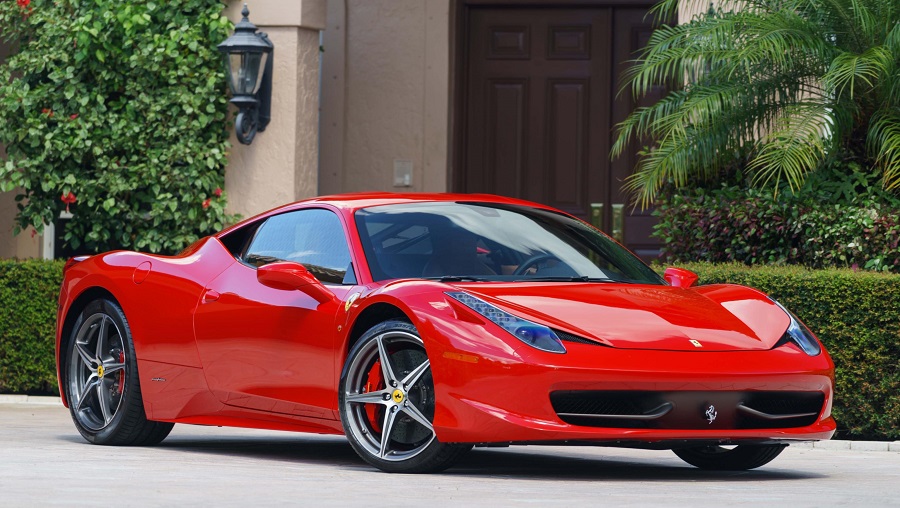
Ferrari 458
Pros: excellent engine and handling.
Cons: expensive.
For the first half of the 2010s, the Ferrari 458 Italia was a dominant force. It was the first Ferrari model in a long time to really stamp the Prancing Horse’s authority on the supercar market segment. It’s true that Ferrari had been riding on its reputation for a little while in the decades previous, but with the 458, it reminded us exactly why it had earned that reputation in the first place.
The key, as with the Mk1 R8, is balance. The 458 Italia’s F-Series V8 and its meticulously crafted chassis felt harmonized to an extent that rival cars just couldn’t quite match. Take the McLaren MP4, for example – a hugely capable machine, but one that undoubtedly lacked the theatre that the 458 could provide. Whether it be its symphonic exhaust note or the way it fed back information to the driver, the 458 Italia gave you exactly the sort of experience that supercars are born to provide. Is there any higher praise than that?
If you’ve got a bit of extra wedge in your back pocket, consider the 488 GTB as well. A newer car, it takes the 458’s recipe and just makes it that little bit better. Though, do bear in mind that while its turbos arguably make it a fiercer prospect on track, it does slightly lack the bravado of the 458’s naturally-aspirated block. And hence, you can understand why the 458 remains our pick.
How much?
- $170,000-$250,000
- £115,000-£185,000
That concludes our list of the best used cars to buy in 2023. We’ll continue to update this article throughout the year to reflect market changes.
Why buy a used car in 2023?
Following chip shortages around the world and lockdowns from 2020-2022, new car production rates slowed massively. As a result, the rush to buy used cars drove up prices for pretty much every model imaginable. From humble Hondas and Fords, JDM classics right up to supercars, everything rose in value. However, now that chip shortages are easing and production across the world has ramped up, new car delivery delays are decreasing. As a result, more people are ordering new cars, thus driving demand in the used car market down, along with it, prices, which is expected to continue throughout 2023.
The cars above all feature elements that most new cars can’t deliver on. Whether that’s a high-revving, naturally-aspirated straight-six, a supercharged Hemi V8 or a highly-tunable 3.0-liter turbocharged six-pot; new cars adhere to strict noise regulations, so you don’t experience the same level of thrills.
Looking to buy one of these cars? Check out Car Gurus.
Words by Dan Bevis & James Bowers

